The History Book Club discussion

This topic is about
The Liberation Trilogy Boxed Set
THE SECOND WORLD WAR
>
SECOND WORLD WAR - THE LIBERATION TRILOGY - GLOSSARY - PART ONE ~ (SPOILER THREAD)
 Edwin Martin "Pa" Watson
Edwin Martin "Pa" Watson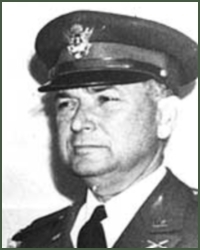
Edwin Martin "Pa" Watson (10 December 1883 – 20 February 1945) was a United States Army Major General, friend and a senior aide to President Franklin D. Roosevelt, serving both as a military advisor and Appointments secretary (a role that is now encompassed under the duties of the modern-day White House Chief of Staff). Edwin M. Watson was born on December 10, 1883 in Eufaula, Alabama. He was raised in Virginia, the son of a businessman in the tobacco industry.
He attended the United States Military Academy at West Point, among contemporaries George S. Patton and Jonathan Wainwright. Watson entered with the Class of 1906 on June 16, 1902, but was discharged for a deficiency in mathematics on April 9, 1903. He was readmitted as a plebe on August 23, 1903, but resigned in the middle of his third class year on December 29, 1904. He re-entered the Academy as a member of the third class in August 1905 and graduated in the Class of 1908.
His classmates gave him the nickname "Pa" for his precociously parental ways and wisdom. He was commissioned a second lieutenant in the Infantry. He served overseas twice, in the Philippines and Mexico, before being transferred back to the United States in 1915. There, he gained his first experience with Presidential service, acting as a junior military aide to President Woodrow Wilson.
Shortly after America’s entry into the First World War in April 1917, Watson requested an active duty assignment with the American Expeditionary Force heading for the front in France. He served there for the remainder of the war, earning the U.S. Army Silver Star and the Croix de Guerre from the French government. He remained in France for the Paris Peace Conference to write the Treaty of Versailles to formally end the First World War. There, he again worked for the adoption of President Woodrow Wilson’s Fourteen Points to guide the post-war world.
Association with FDR
He would continue this pattern of service until becoming Senior Military Aide to the newly-inaugurated President Franklin D. Roosevelt in 1933. He helped FDR navigate the bureaucracy of the War Department and the Army, especially during the crucial years prior to America’s entry into the Second World War. He was also appointed the President's Appointments secretary in 1938 after the previous secretary Marvin H. McIntyre's illness prevented him from continuing with his duties, managing access to the President and dictating the tenor of his daily schedule.
Watson lived with his wife, professional pianist Frances Nash Watson, on a Virginia estate called Kenwood. The land, just beyond Monticello, was once owned by Thomas Jefferson, and the estate house was designed by FDR's cousin, celebrated architect William A. Delano. Watson and FDR were personally close above and beyond their close professional ties, and FDR adopted Kenwood as his "Camp David" during his presidency and retreated there on several occasions for vacation. The guest cottage was built in 1940-41 for Roosevelt, though he stayed there on only one occasion, preferring the social activity of the main house. On subsequent visits, including four days in June 1944 while awaiting the Normandy invasion, he slept in the front bedroom of the main house. Mrs. Watson later bequeathed Kenwood to the University of Virginia, which in turn has leased the property to the Thomas Jefferson Foundation.
Watson and FDR's son James, were the ones who enabled Roosevelt to stand and to walk on the occasions when he did. Roosevelt had to wear steel braces. Watson and James, on those occasions would support him on his left arm.
By virtue of his proximity to the President, Watson was present at some of the defining moments of the Second World War. These included FDR’s agreement to the Atlantic Charter alongside British Prime Minister Winston Churchill, providing a framework for that values that would guide the post-war world. He was in constant contact with Generals Dwight D. Eisenhower and Douglas MacArthur and Admiral Nimitz. He attended the Teheran Conference where the first of the negotiations between FDR, Churchill, and Soviet Premier Joseph Stalin took place. Although in poor health, he attended the Yalta Conference in February 1945 as well, where the Big Three negotiated for the future of Europe. On the return voyage, he suffered a fatal cerebral hemorrhage and died at sea.
General Watson was buried with full military honors in Arlington Cemetery with the President in attendance. The President himself died two months later in April.
The War Department, in recognition of his service, posthumously awarded him the Distinguished Service Medal, which was presented by President Harry Truman and Eleanor Roosevelt to his widow Frances Nash Watson.
(Source: http://en.wikipedia.org/wiki/Edwin_%2...)
More:
http://theworldsmilitaryhistory.wikia...
http://ead.lib.virginia.edu/vivaxtf/v...
http://www.arlingtoncemetery.net/emwa...
 Thanks to you all for these very valuable insights in this Glossary section. I read my books as eBooks on my iPad and got involved with Goodreads very recently, so I missed out on the free advance copies of Roosevelt's Centurions: FDR & the Commanders He Led to Victory in World War II. Your Glossary information is extremely helpful to those of us who have to wait until May 28th to get our copy of the book. I am also supplementing my knowledge by rereading Andrew Roberts' Masters and Commanders: How Churchill, Roosevelt, Alanbrooke and Marshall Won the War in the West - 1941-45
Thanks to you all for these very valuable insights in this Glossary section. I read my books as eBooks on my iPad and got involved with Goodreads very recently, so I missed out on the free advance copies of Roosevelt's Centurions: FDR & the Commanders He Led to Victory in World War II. Your Glossary information is extremely helpful to those of us who have to wait until May 28th to get our copy of the book. I am also supplementing my knowledge by rereading Andrew Roberts' Masters and Commanders: How Churchill, Roosevelt, Alanbrooke and Marshall Won the War in the West - 1941-45
 . I only got 40% of the way through this book before getting sidetracked many months ago.
. I only got 40% of the way through this book before getting sidetracked many months ago.
 Thanks Steven, glad you will be participating in the discussion. Don't forget to use the proper citation when mentioning a book. It is easier to read if you put it at the bottom of your post. Book cover, author photo (when available) and author link. You don't need the book title, but had the other two elements right just not in the right order. You do not need to link to the Centurions book as long as you are on the thread specifically discussing the book.
Thanks Steven, glad you will be participating in the discussion. Don't forget to use the proper citation when mentioning a book. It is easier to read if you put it at the bottom of your post. Book cover, author photo (when available) and author link. You don't need the book title, but had the other two elements right just not in the right order. You do not need to link to the Centurions book as long as you are on the thread specifically discussing the book.Glad you are finding good info on the glossary. We are adding to it steadily, as you can see. Stay tuned, there will be much more to come!
 by Andrew Roberts
by Andrew Roberts
 Jill wrote: "Irwin Rommel
Jill wrote: "Irwin RommelErwin Rommel was born in Heidenheim, Germany, on 15th November, 1891. He wanted to study engineering but his father disapproved so in 1910 he joined the German Army.
I would like to add the following quote concerning Rommel's performance in the German blitzkrieg across France, as taken from Wikipedia's article on Erwin Rommel: "At the time there were only ten panzer divisions in the army.[23] Three months before Fall Gelb (Case Yellow: the planned invasion of France and the Low Countries), on 6 February 1940, Rommel was given command of the 7th Panzer Division. Rommel was well known by the men in the division as an Alpine infantry commander, and there was some doubt among them over his ability to handle mechanized units.[24] However Rommel's successes in World War I were based on surprise and maneuver, two elements the new panzer units were ideally suited for. Upon taking command he quickly set his unit to practicing the maneuvers they would need in the upcoming campaign.[25] The decision to place him in command of an armoured division was soon borne out to be an excellent one. In the upcoming invasion of France in May 1940 his 7th Panzer Division would become known as the "Ghost Division", called this because its fast paced attacks and rapid advances often placed it so far forward that their actual position was not known, and they were frequently out of communication with the German high command."a>
 Interesting, Steven. Warfare operations were so different than they are today, interesting to see how that influenced command style and abilities.
Interesting, Steven. Warfare operations were so different than they are today, interesting to see how that influenced command style and abilities.
 US Constitution, Article II Section II
US Constitution, Article II Section IIPresidential powers
In the landmark decision Nixon v. General Services Administration former Chief Justice of the United States William Rehnquist declared in his dissent the need to "fully describe the preeminent position that the President of the United States occupies with respect to our Republic. Suffice it to say that the President is made the sole repository of the executive powers of the United States, and the powers entrusted to him as well as the duties imposed upon him are awesome indeed."
Command of military; Opinions of cabinet secretaries; Pardons
The President shall be Commander in Chief of the Army and Navy of the United States, and of the Militia of the several States, when called into the actual Service of the United States; he may require the Opinion, in writing, of the principal Officer in each of the executive Departments, upon any Subject relating to the Duties of their respective Offices, and he shall have Power to grant Reprieves and Pardons for Offenses against the United States, except in Cases of Impeachment.
The President is the military's commander-in-chief; however Article One gives Congress and not the President the exclusive right to declare war. Presidents have often deployed troops with Congressional authorization, but without an explicit declaration of war. According to historian Thomas Woods, "Ever since the Korean War, Article II, Section 2 of the Constitution — which refers to the president as the 'Commander in Chief of the Army and Navy of the United States' — has been interpreted to mean that the president may act with an essentially free hand in foreign affairs, or at the very least that he may send men into battle without consulting Congress." Since World War II, every major military action has been technically a U.S. military operation or a U.N. "police action", which are deemed legally legitimate by Congress, and various United Nations Resolutions because of decisions such as the Gulf of Tonkin Resolution or the Authorization for Use of Force.
The President may require the "principal officer" of any executive department to tender his advice in writing. Thus, implicitly, the Constitution creates a Cabinet that includes the principal officers of the various departments.
The President, furthermore, may grant pardon or reprieves, except in cases of impeachment. Originally, as ruled by the Supreme Court in United States v. Wilson (1833), the pardon could be rejected by the convict. In Biddle v. Perovich, 274 U.S. 480 (1927), however, the Supreme Court reversed the doctrine, ruling that "[a] pardon in our days is not a private act of grace from an individual happening to possess power. It is a part of the Constitutional scheme. When granted it is the determination of the ultimate authority that the public welfare will be better served by inflicting less than what the judgment fixed.
Advice and Consent Clause
The President exercises the powers in the Advice and Consent Clause with the advice and consent of the Senate.
He shall have Power, by and with the Advice and Consent of the Senate, to make Treaties, provided two thirds of the Senators present concur; and he shall nominate, and by and with the Advice and Consent of the Senate, shall appoint Ambassadors, other public Ministers and Consuls, Judges of the supreme Court, and all other Officers of the United States, whose Appointments are not herein otherwise provided for, and which shall be established by Law: but the Congress may by Law vest the Appointment of such inferior Officers, as they think proper, in the President alone, in the Courts of Law, or in the Heads of Departments.
Treaties
The President may enter the United States into treaties, but they are not effective until ratified by a two-thirds vote in the Senate. In Article II however, the Constitution is not very explicit about the termination of treaties. The first abrogation of a treaty occurred in 1798, when Congress passed a law terminating a 1788 treaty with France. In the nineteenth century, several Presidents terminated treaties after Congress passed resolutions requesting the same. In 1854, however, President Franklin Pierce terminated a treaty with Denmark with the consent of the Senate alone. A Senate committee ruled that it was correct procedure for the President to terminate treaties after being authorized by the Senate alone, and not the entire Congress. President Pierce's successors, however, returned to the former procedure of obtaining authorization from both Houses. Some Presidents have claimed to themselves the exclusive power of terminating treaties. Abraham Lincoln, for instance, terminated a treaty without prior Congressional authorization, but Congress retroactively approved his decision at a later point. The first unambiguous case of a President terminating a treaty without authorization, granted prior to or after the termination, occurred when Jimmy Carter terminated a treaty with the Republic of China.[6] For the first time, judicial determination was sought, but the effort proved futile: the Supreme Court could not find a majority agreeing on any particular principle, and therefore instructed the trial court to dismiss the case.
Appointments
The President may also appoint judges, ambassadors, consuls, ministers and other officers with the advice and consent of the Senate. By law, however, Congress may allow the President, heads of executive departments, or the courts to appoint inferior officials.
The Senate has a long-standing practice of permitting motions to reconsider previous decisions. In 1931, the Senate granted advice and consent to the President on the appointment of a member of the Federal Power Commission. The officer in question was sworn in, but the Senate, under the guise of a motion to reconsider, rescinded the advice and consent. In the writ of quo warranto proceedings that followed, the Supreme Court ruled that the Senate was not permitted to rescind advice and consent after the officer had been installed.
After the Senate grants advice and consent, however, the President is under no compulsion to commission the officer. It has not been settled whether the President has the prerogative to withhold a commission after having signed it. This issue played a large part in the famous court case Marbury v. Madison.
At times the President has asserted the power to remove individuals from office. Congress has often explicitly limited the President's power to remove; during the Reconstruction Era, Congress passed the Tenure of Office Act, purportedly preventing Andrew Johnson from removing, without the advice and consent of the Senate, anyone appointed with the advice and consent of the Senate. President Johnson ignored the Act, and was later impeached and acquitted. The constitutionality of the Act was not immediately settled. In Myers v. United States, 272 U.S. 52 (1926), the Supreme Court held that Congress could not limit the President's power to remove an executive officer (the Postmaster General), but in Humphrey's Executor v. United States, 295 U.S. 602 (1935) it upheld Congress's authority to restrict the President's power to remove officers of the Federal Trade Commission, an "administrative body [that] cannot in any proper sense be characterized as an arm or eye of the executive."
Congress may repeal the legislation that authorizes the appointment of an executive officer. But it "cannot reserve for itself the power of an officer charged with the execution of the laws except by impeachment." Congress has from time to time changed the number of justices in the Supreme Court.
Recess appointments
The President shall have Power to fill up all Vacancies that may happen during the Recess of the Senate, by granting Commissions which shall expire at the End of their next Session.
During recesses of the Senate, the President may appoint officers, but their commissions expire at the conclusion of the Senate's next session. For example, see George W. Bush's 2005 appointment of John Bolton as U.N. Ambassador.
(Source: http://en.wikipedia.org/wiki/Article_...)
More:
http://www.goodreads.com/topic/group_...
http://www.usconstitution.net/const.h...
http://www.law.cornell.edu/anncon/htm...
 by
by
 James Madison
James Madison by Erin Ackerman
by Erin Ackerman by William G. Howell
by William G. Howell
 William Christian Bullitt, Jr.
William Christian Bullitt, Jr. 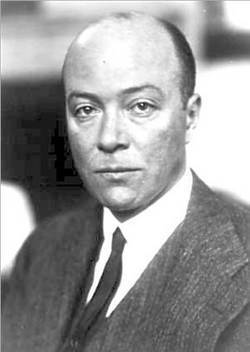
William Christian Bullitt, Jr. (January 25, 1891 – February 15, 1967) was an American diplomat, journalist, and novelist. Although in his youth he was considered something of a radical, he later became an outspoken anticommunist.
Bullitt was born to a well-to-do old Philadelphia family. His mother was Louisa Gross (Horowitz), his father was William Christian Bullitt, Sr., and his grandfather was John Christian Bullitt, founder of the law firm today known as Drinker Biddle & Reath. He graduated from Yale University in 1913, after having been voted "most brilliant" in his class. He briefly attended Harvard Law School but dropped out on the death of his father in 1914. At Yale he was a member of Scroll and Key.
He married socialite Aimee Ernesta Drinker in 1916. She gave birth to a son in 1917, but the baby died after two days. They divorced in 1923. In 1924 he married Louise Bryant, widow of radical journalist John Reed. They divorced in 1930 after he discovered her affair with English sculptor Gwen Le Gallienne. In 1924, the Bullitts had a daughter, Anne Moen Bullitt, who in 1967 married U.S. Senator Daniel Brewster as her fourth husband.
Bullitt became a foreign correspondent in Europe and later a novelist. In 1926, he published It's Not Done, a satirical novel that the New York Times described as "a novel of ideas, whose limitation is that it is a volley, a propaganda novel, directed against a single institution, the American aristocratic ideal, and whose defect is that the smoke does not quite clear away so that one can accurately count the corpses."
Diplomatic career
Working for Woodrow Wilson at the Paris Peace Conference, in 1919, Bullitt was a strong supporter of legalistic internationalism, subsequently known as Wilsonianism. Prior to the negotiation of the Versailles accords, Bullitt, along with journalist Lincoln Steffens and Swedish Communist Karl Kilbom, undertook a special mission to Soviet Russia to negotiate diplomatic relations between the US and the Bolshevik regime. Having failed to convince Wilson to support the establishment of relations with the Bolshevik government, Bullitt resigned from Wilson's staff.
He later returned to the United States and testified in the Senate against the Treaty of Versailles and had his report of his Russian trip placed into the record.
First US ambassador to the Soviet Union
Franklin D. Roosevelt appointed Bullitt the first US ambassador to the Soviet Union, a post that he filled from 1933 to 1936. At the time of his appointment, Bullitt was known as a liberal and thought by some to be something of a radical.[citation needed] The Soviets welcomed him as an old friend because of his diplomatic efforts at the Paris Peace Conference in 1919. Though Bullitt arrived in the Soviet Union with high hopes for Soviet-American relations, his view of the Soviet leadership soured on closer inspection. By the end of his tenure he was openly hostile to the Soviet government. He remained an outspoken anticommunist for the rest of his life. Bullitt was recalled after US journalist Donald Day had disclosed that he had been involved in illegal exchange of and trading with Torgsin ruble.
During this period, he was briefly engaged to Roosevelt's personal secretary, Missy LeHand. However, she broke off the engagement after a trip to Moscow on which she reportedly discovered him to be having an affair with a ballet dancer.
On April 24, 1935, he hosted a Spring Festival at Spaso House, his official residence. He instructed his staff to create an event that would surpass every other Embassy party in Moscow's history. The decorations included a forest of ten young birch trees in the chandelier room, a dining room table covered with Finnish tulips, a lawn made of chicory grown on wet felt; an aviary made from fishnet filled with pheasants, parakeets, and one hundred zebra finches, on loan from the Moscow Zoo; and a menagerie of several mountain goats, a dozen white roosters, and a baby bear.
The four hundred guests included Foreign Minister Maxim Litvinov and Defense Minister Kliment Voroshilov; Communist Party luminaries Nikolai Bukharin, Lazar Kaganovich, and Karl Radek; Soviet Marshals Alexander Yegorov, Mikhail Tukhachevsky, and Semyon Budyonny; and the writer Mikhail Bulgakov.
The festival lasted until the early hours of the morning. The bear became drunk on champagne given to him by Karl Radek, and in the early morning hours the zebra finches escaped from the aviary and perched below the ceilings around the house. Bulgakov described the party as "The Spring Ball of the Full Moon" in his novel The Master and Margarita. On October 29, 2010, Ambassador John Beyrle recreated Bullitt's ball with his own Enchanted Ball, dedicated to Bullitt and Bulgakov.
Ambassador to France
Bullitt was posted to France in October 1936 as Ambassador. Fluent in French and an ardent Francophile, Bullitt became established in Paris society and rented a château at Chantilly. He owned at least 18,000 bottles of French wine. As a close friend of President Franklin D. Roosevelt, with whom he had daily telephone conversations, Bullitt was widely regarded as Roosevelt's personal envoy to France, and as such was a man much courted by French politicians. Bullitt was especially close to Léon Blum and Édouard Daladier, and had cordial but not friendly relations with Georges Bonnet. Historians have criticized Bullitt for being too influenced by the last person to whom he spoke and for including too much gossip in his dispatches to Washington.
On September 4, 1938 in the midst of the great crisis in Europe that was to culminate in the Munich Agreement, during the unveiling of a plaque in France honoring Franco-American friendship, Bullitt stated that "France and the United States were united in war and peace", leading to much speculation in the press that if war did break over Czechoslovakia, the United States would join the war on the Allied side. On September 9, 1938, Roosevelt denied that the US would fight on the Allied side in the event that war broke out over Czechoslovakia.
In 1939 Prime Minister Édouard Daladier informed him French intelligence knew that Alger Hiss in the United States Department of State was working for Soviet intelligence. Bullitt passed the information along to Hiss's superior at the State Department.
After the German invasion of France in 1940, Bullitt fell out with Roosevelt. Bullitt insisted on remaining in Paris as the only ambassador of a major nation left when the Germans marched in. This angered Roosevelt, who believed Bullitt should have followed the French government to Bordeaux to look after US interests. Once thought of as a potential cabinet member, he found his career blocked.
Campaign against Sumner Welles
In the late 1930s, the State Department was divided by rivalry between Secretary of State Cordell Hull and Undersecretary Sumner Welles, who was Roosevelt's favorite. Bullitt, who disliked Welles, was allied with Hull and Department Counselor R. Walton Moore.
In September 1940, Welles, while drunk, made homosexual propositions to a pair of railroad porters. Bullitt learned of this incident through Moore, who at his death passed affidavits sworn by the propositioned porters to Bullitt. Bullitt used this information to campaign for Welles's resignation. Roosevelt long resisted taking any action against Welles. Elliot Roosevelt later wrote that his father believed that Bullitt had bribed the porters to make overtures to Welles to entrap him.
On April 23, 1941, Bullitt confronted the President with his evidence, but Roosevelt refused to yield to Bullitt's demands and dismissed him from any further significant duties with the State Department. At one point, he suggested to Hull that Bullitt should be appointed Ambassador to Liberia, one of the worst postings in the Foreign Service.[17] In 1942, Bullitt pushed the story to Vice President Henry A. Wallace and to Secretary Hull. Roosevelt told Wallace that Bullitt ought to "burn in hell" for what he was saying about Welles. In early 1943, Hull began to demand Welles' removal. Bullitt now informed Senator Owen Brewster, a Republican, a strong opponent of Roosevelt. Brewster threatened a senatorial inquiry. The potential scandal forced Roosevelt to act, and on September 30, 1943, Welles resigned. Roosevelt remained very angry with Bullitt and refused to give Bullitt any government post.
Post-diplomatic career
Denied a commission in the US Armed Forces by Roosevelt, Bullitt joined the Free French Forces. Roosevelt suggested to Bullitt to run for Mayor of Philadelphia as a Democrat in 1943, but Roosevelt secretly told the Democratic leaders there "Cut his throat." Bullitt was defeated.
Between 1941 and 1945 Bullitt wrote volumes of stories and social commentary on the dangers of fascism and Communism. In the post-war years he became a militant anticommunist.
In the August 24, 1954 issue of Look, in his article "Should We Support an Attack on Red China?", he proposed an immediate attack on Communist China and asserted that the United States should "reply to the next Communist aggression by dropping bombs on the Soviet Union."
Bullitt died in Neuilly, France on February 15, 1967, and is buried in Woodlands Cemetery in Philadelphia
(Source: http://en.wikipedia.org/wiki/William_....)
More:
http://www.unc.edu/depts/diplomat/arc...
http://www.wcbullittfound.org/history
http://www.nndb.com/people/162/000127...
http://select.nytimes.com/gst/abstrac...
 by Will Brownell
by Will Brownell by William C. Bullitt
by William C. Bullitt by Michael Cassella-Blackburn
by Michael Cassella-Blackburn by
by
 Sigmund Freud
Sigmund Freud
 Cordell Hull
Cordell Hull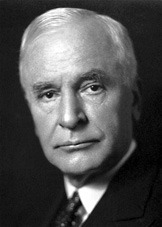
Cordell Hull (October 2, 1871-July 23, 1955) was born in a log cabin in present day Pickett County, Tennessee (Overton County until 1879), the third of the five sons of William and Elizabeth (Riley) Hull. His father was a farmer and subsequently a lumber merchant. The only one of the five boys who showed an interest in learning, Cordell wanted to be a lawyer. He obtained his elementary school training in a one-room school that his father had built in nearby Willow Grove; then for a period of about three years, he attended in succession the Mountvale Academy at Celina, Tennessee, the Normal School at Bowling Green, Kentucky, and the National Normal University at Lebanon, Ohio. He received a law degree in 1891 after completing a one-year course at Cumberland University at Lebanon, Tennessee.
Not yet twenty, Hull began the practice of law in Celina, but having participated in political campaigning even while a student, decided to run for the state legislature. From 1893 to 1897 he was a member of the Tennessee House of Representatives, abandoning politics temporarily to serve as captain of the Fourth Tennessee Regiment in the Spanish-American War. Hull returned to the practice of law in Gainesboro, Tennessee, but in 1903 was appointed Judge of the Fifth Judicial District. He held his position until 1907.
Hull's Public Life
Elected to Congress from the Fourth Tennessee District in 1907, Hull served as a U.S. Representative until 1931, interrupted only by two years as Chairman of the Democratic National Committee. In his distinguished career in Congress, Hull was a member of the House Ways and Means Committee for eighteen years, leader of the movement for low tariffs, the author of the first Federal Income Tax Bill (1913), the Revised Act (1916), and the Federal and State Inheritance Tax Law (1916), as well as the drafter of a resolution providing for the convening of a world trade agreement congress at the end of World War I. He became a recognized expert in commercial and fiscal policies.
Hull was elected U.S. Senator for the 1931-1937 term but resigned upon his appointment as secretary of state by the age of sixty-two. In 1944 when he resigned because of ill health, he had occupied this post for almost twelve years, the longest tenure in American History.
He headed the American Delegation to the Monetary and Economic Conference in London in July 1933, a conference which ended in failure. Despite this failure, in November of that year he headed the American Delegation to the Seventh Pan-American Conference, held in Montevideo Uraguay, and there won the trust of the Latin American diplomats, laying the foundation for the "Good Neighbor" Policy, followed up in the Inter-American Conference for the Maintenance of Peace held in Buenos Aires (1936) , the eighth Pan-American Conference in Lima (1938), the second consecutive Meeting of Ministers of Foreign Affairs of the American Republics in Havana (1940). Given authority through the Trade Agreements Act of 1934, he negotiated reciprocal trade agreements with numerous countries, lowering tariffs and stimulating trade.
Hull was responsive to the problems arising in other parts of the globe. From 1936 on, foreseeing danger to peace in the rise of dictators, he advocated rearmament, pled for the implementation of a system of collective security, opposed Japanese encroachment into Indochina, warned all branches of the U.S. Military well in advance of the attack on Pearl Harbor to prepare to resist simultaneous, surprise attacks at various points.
The Seeds of the United Nations
Shortly after the outbreak of the war, Hull proposed the formation of a new world organization in which the United Stated would participate after the war. To accomplish this aim, in 1941 he formed an Advisory Committee on Postwar Foreign Policy composed of both Republicans and Democrats. Mindful of President Wilson's failure with the League of Nations, Hull took pains to keep discussion of the organization nonpartisan. By August, 1943, the State Department had drafted a document entitled "Charter of the United Nations," which became the basis for proposals submitted by the United States at the 1944 Dumbarton Oaks Conference. Ill health forced Hull to resign from office on November 27, 1944 before final ratification of the United Nations Charter in San Francisco. President Roosevelt praised Secretary Hull as "the one person in all the world who has done his most to make this great plan for peace an effective fact."
Prior to Secretary Hull's resignation, President Roosevelt offered him the Vice Presidency in his bid for election. Because of his health, Hull declined, and Harry Truman became Vice President.
The Nobel Peace Prize
Following nomination by Roosevelt, the Norwegian Nobel Committee presented the 1945 Nobel Prize for Peace to Hull in recognition of his work in the Western Hemispheres, for his International Trade Agreements, and for his efforts in establishing the United Nations. Too ill to receive the award in person, Hull sent a brief acceptance speech that was delivered by the United States Ambassador to Norway, Mr. Lithogow Osborne. In his acceptance speech for the Nobel Peace Prize, Hull wrote:
"Under the ominous shadow which the Second World War and its attendant circumstances have cast on the world, peace has become as essential to civilized existence as the air we breathe is to life itself. There is no greater responsibility resting upon peoples and governments everywhere, than to make sure that enduring peace will this time...at long last...be established and maintained...The searing lessons of this latest war and the promise of the United Nations Organization will be the cornerstones of a new edifice of enduring peace and the guideposts of a new era of human progress."
The Personal Life of Cordell Hull
Cordell Hull was a quiet,and dedicated man. His whole life was so immersed in politics that he did not get married until 1917 at age 46, when he married Rose Frances Witz.. He and Rose had no children. Hull hated the social life of Washington, preferring instead the simplicity of his private life and his other work. Other than a mild interest in golf and croquet, he spent little time on anything but his work.
His will provided the placing of the artifacts and books from his private apartment in a museum which was opened in Pickett County, Tennessee in September 1996. With financing from the State of Tennessee, this was made possible by his niece, Katherine Hull Ethridge, and the inexhaustible efforts of The Friends of Cordell Hull, a nonprofit organization dedicated to preserving his life and work.
Cordell Hull's nearly twelve-year tenure as Secretary of State has never been exceeded in length. He is widely regarded as one of the greatest Secretaries. British diplomat Lord Halifax, praised Hull as "a great example to statesmen of any country...universally respected, known, and trusted."
(Source: http://www.cordellhullmuseum.com/hist...)
More:
http://en.wikipedia.org/wiki/Cordell_...
http://millercenter.org/president/fdr...
http://www.nobelprize.org/nobel_prize...
http://history.state.gov/departmenthi...
http://bioguide.congress.gov/scripts/...
 by Mark Dudney
by Mark Dudney by Harold B. Hinton
by Harold B. Hinton by Irwin Gellman
by Irwin Gellman
 One thing I like to look at when studying a war is good maps; some of the best are military maps. This site http://militarymaps.narod.ru/index_e.... has thousands, but it requires downloading a viewer and I wasn't sure about our policy on that.
One thing I like to look at when studying a war is good maps; some of the best are military maps. This site http://militarymaps.narod.ru/index_e.... has thousands, but it requires downloading a viewer and I wasn't sure about our policy on that.
 Thanks Peter, another great resource folks can use. The images we post have certain formatting requirements but others can certainly consult a link like this on their own. Good find.
Thanks Peter, another great resource folks can use. The images we post have certain formatting requirements but others can certainly consult a link like this on their own. Good find.
 Charles Evans Hughes
Charles Evans Hughes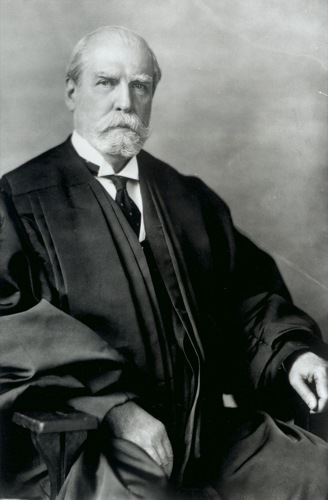
Charles Evans Hughes was born and raised in New York. He was educated by his parents but matriculated at Madison College (now Colgate) when he was fourteen. He completed his undergraduate education at Brown. Hughes taught briefly before entering Columbia Law School. He scored an amazing 99 1/2 on his bar exam at the age of 22. He practiced law in New York for 20 years, though he did hold an appointment at Cornell Law School for a few years in that period.
Hughes earned national recognition for his investigation into illegal rate- making and fraud in the insurance industry. With an endorsement from Theodore Roosevelt, Hughes ran successfully for New York governor, defeating Democrat William Randolph Hearst in 1906. In 1910, Hughes accepted nomination to the High Court from President Taft. Six years later, Hughes resigned to run against Woodrow Wilson for the presidency as the nominee of the Republican and Progressive Parties. He lost by a mere 23 electoral votes.
After a brief stint in private practice, Hughes was called to politics again, this time as secretary of state for Warren G. Harding. Hughes continued in this role during the presidency of Calvin Coolidge. Hughes's nomination to be chief justice met with opposition from Democrats who viewed Hughes as too closely aligned with corporate America. Their opposition was insufficient to deny Hughes the center chair, however.
Hughes authored twice as many constitutional opinions as any other member of his Court. His opinions, in the view of one commentator, were concise and admirable, placing Hughes in the pantheon of great justices.
Hughes had remarkable intellectual and social gifts that made him a superb leader and administrator. He had a photographic memory that few, if any, of his colleagues could match. Yet he was generous, kind, and forebearing in an institution where egos generally come in only one size: extra large!
(Source: http://oyez.org/justices/charles_e_hu...)
More:
http://en.wikipedia.org/wiki/Charles_...
http://www.supremecourthistory.org/hi...
http://thecontenders.c-span.org/Conte...
http://www.infoplease.com/encyclopedi...
 by William G. Ross
by William G. Ross
 America First Committee
America First Committee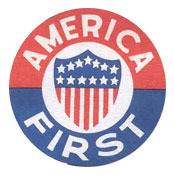
The America First Committee (AFC) was organized in September 1940 to oppose America`s potential intervention in World War II. Hitler`s invasion of Poland had precipitated war in September 1939. A year later, the only major military force resisting the Nazis was Britain. The smaller nations had been quickly overrun, France had capitulated, and the Soviet Union was using its nonagression pact with Germany to pursue its own interests in Finland and elsewhere. At the time, a majority of Americans felt that while the world would be a better place if Britain prevailed over Germany, they were not inclined to declare war and repeat the earlier experience of American soldiers fighting on European soil.
This reluctance had inspired Congress to pass neutrality acts in the late 1930`s which restricted the American government`s ability to support either party in the conflict, which in practice meant the Allies since the Axis powers were widely regarded with distaste. Roosevelt, who had been corresponding with Churchill for years before Churchill was even part of the Tory government, clearly identified American interests with the hope for British victory. Using tactics like the "bases for destroyers" deal, he attempted to maximize his support for the British while skirting if not actually violating the principle of neutrality.
The AFC opposed him at every step. Its membership, which grew to around 800,000 by early 1941, was national in character while especially strong in the Midwest. Its best known leader was Charles A. Lindbergh, who was accompanied by an amazing array that included critics of Roosevelt from the right (Col. McCormick of the Chicago Tribune) and the left (the socialist Norman Thomas), along with stolid isolationists (senators Burton Wheeler of Kansas and William A. Borah of Idaho) and the anti-semitic Father Edward Coughlin.
When Lend-Lease was proposed by Roosevelt in the winter of 1941, the AFC was strongly opposed. Lindbergh gave speeches across the country, emphasizing that support for Britain was sentimental and misguided. His main points were that geographically, it was impossible to imagine Britain defeating Germany from its island air bases or for an invasion of the European continent with the million men that would be required for victory. He argued that while fighting a war in Europe would be a disaster for the United States, geography greatly favored a defensive position that would allow it to hold the entire Western Hemisphere against any aggressor.
The AFC and its supporters lost the debate on Lend-Lease, which Congress passed, giving Roosevelt broad powers to provide material support to the Allies. When the Nazis invaded the Soviet Union in June 1941, Communist support for the AFC evaporated. By the fall, with war coming ever closer, the AFC`s influence was dwindling.
The end came quickly. Four days after the Japanesee attack on Pearl Harbor on December 7, 1941, the AFC dissolved itself. In its final statement, the committee declared that while its policies might have prevented war, that war was now a reality and it had become the duty of American to work for the united goal of victory.
The AFC`s stance demonstrated the limits and perils of "realism" in foreign policy. Lindbergh`s analysis of the military situation in 1940 was largely correct, but had his ideas prevailed, Britain might not have survived long enough to benefit from Hitler`s rash and ultimately disastrous decision to invade Russia.
(Source: http://www.u-s-history.com/pages/h164...)
More:
http://www.spartacus.schoolnet.co.uk/...
http://en.wikipedia.org/wiki/America_...
http://www.pbs.org/wgbh/amex/lindberg...
http://www.oac.cdlib.org/findaid/ark:...
An American first: John T. Flynn and the America First Committee (no cover) by Michele Stenehjem Gerber
A Story of America First: The Men and Women Who Opposed U.S. Intervention in World War II (no cover) by Ruth Sarles
 Winston Churchill
Winston Churchill
Sir Winston Leonard Spencer-Churchill, KG, OM, CH, TD, DL, FRS, Hon. RA (30 November 1874 – 24 January 1965) was a British politician who was the Prime Minister of the United Kingdom from 1940 to 1945 and again from 1951 to 1955. Widely regarded as one of the greatest wartime leaders of the 20th century, Churchill was also an officer in the British Army, a historian, a writer, and an artist. He is the only British Prime Minister in history to have received the Nobel Prize in Literature, and was also the first person to be made an Honorary Citizen of the United States.
Churchill was born into an aristocratic family as the grandson of the 7th Duke of Marlborough. His father, Lord Randolph Churchill, was a charismatic politician who served as Chancellor of the Exchequer; his mother, Jennie Jerome, was an American socialite. As a young army officer, he saw action in British India, The Sudan, and the Second Boer War. He gained fame as a war correspondent and wrote books about his campaigns.
At the forefront of politics for fifty years, he held many political and cabinet positions. Before the First World War, he served as President of the Board of Trade, Home Secretary, and First Lord of the Admiralty as part of the Asquith Liberal government. During the war, he continued as First Lord of the Admiralty until the disastrous Gallipoli Campaign caused his departure from government. He then briefly resumed active army service on the Western Front as commander of the 6th Battalion of the Royal Scots Fusiliers. He returned to government as Minister of Munitions, Secretary of State for War, and Secretary of State for Air. After the War, Churchill served as Chancellor of the Exchequer in the Conservative (Baldwin) government of 1924–29, controversially returning the pound sterling in 1925 to the gold standard at its pre-war parity, a move widely seen as creating deflationary pressure on the UK economy. Also controversial was his opposition to increased home rule for India and his resistance to the 1936 abdication of Edward VIII.
Out of office and politically "in the wilderness" during the 1930s, Churchill took the lead in warning about Nazi Germany and in campaigning for rearmament. On the outbreak of the Second World War, he was again appointed First Lord of the Admiralty. Following the resignation of Neville Chamberlain on 10 May 1940, Churchill became Prime Minister. His steadfast refusal to consider defeat, surrender, or a compromise peace helped inspire British resistance, especially during the difficult early days of the War when Britain stood alone among European countries in its active opposition to Adolf Hitler. Churchill was particularly noted for his speeches and radio broadcasts, which helped inspire the British people. He led Britain as Prime Minister until victory over Nazi Germany had been secured.
After the Conservative Party lost the 1945 election, he became Leader of the Opposition to the Labour (Attlee) government. After winning the 1951 election, he again became Prime Minister, before retiring in 1955. Upon his death, Elizabeth II granted him the honour of a state funeral, which saw one of the largest assemblies of world statesmen in history.[1] Named the Greatest Briton of all time in a 2002 poll, Churchill is widely regarded as being among the most influential people in British history.
(Source: http://en.wikipedia.org/wiki/Winston_...)
More:
http://www.winstonchurchill.org/
http://www.nobelprize.org/nobel_prize...
http://www.bbc.co.uk/history/people/w...
 and
and
 and
and
 by
by
 William Raymond Manchester
William Raymond Manchester by Roy Jenkins (no photo)
by Roy Jenkins (no photo) by
by
 Paul Johnson
Paul Johnson
 Curtis Roosevelt
Curtis Roosevelt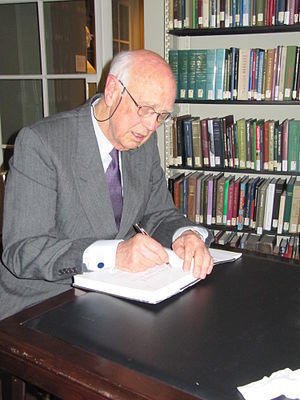
Curtis Roosevelt (born Curtis Roosevelt Dall, briefly Boettiger, April 19, 1930) is the second eldest child of Anna Roosevelt and her first husband, Curtis Bean Dall. He is the eldest grandson of U.S. President Franklin Delano Roosevelt and Eleanor Roosevelt. He is the younger brother of Eleanor Roosevelt Seagraves. Curtis Roosevelt was often referred to as "Buzzie" in 1930s newspapers.
After his parents' divorce, his mother remarried journalist John Boettiger. At a much later point, he decided to be called Curtis Roosevelt Boettiger. When his mother was divorced from her second husband, Eleanor and Anna did not want Curtis to reassume the surname "Dall" so the senior Mrs. Roosevelt suggested he use his middle name as his last name.
Roosevelt served two years in the United States Army and obtained his masters degree from the School of Government and Public Law at Columbia University. Between 1956 and 1964, he worked for a number of schools and committees, including the National Citizens Commission for the Public Schools, the New School for Social Research, Columbia University, and the United States Committee for the United Nations. Beginning in 1964, Roosevelt held various positions in the international civil service of the Secretariat of the United Nations in New York City until 1983. Roosevelt served as principal at the Dartington College of Arts in Devon, England, where he received an honorary bachelors degree in theatre, music, and fine art. Roosevelt retired in 1987.
Roosevelt also became an occasional writer on American politics for El Mundo and Le Figaro newspapers in Spain and France. He lives in the south of France, where he regularly appears on French television.
Roosevelt married four times:
Robin V. Edwards on May 23, 1950 – one child: Julianna E. Roosevelt, born March 15, 1952; one grandson, Nicholas Derby Roosevelt.
Ruth W. Sublette on March 6, 1955
Jeanette Schlottman on May 2, 1961
Marina Roosevelt
(Source: http://en.wikipedia.org/wiki/Curtis_R...)
More:
http://www.pbs.org/wgbh/americanexper...
http://www.huffingtonpost.com/curtis-...
http://www.roosevelthouse.hunter.cuny...
http://money.cnn.com/2010/08/03/news/...
 by Curtis Roosevelt
by Curtis Roosevelt
 Naval Academy at Annapolis
Naval Academy at Annapolis
Founded in 1845 by Secretary of the Navy, George Bancroft, the Academy started as the Naval School on 10 acres of old Fort Severn in Annapolis. Since then, the history of the Naval Academy has reflected the history of the United States. As our country has changed culturally and technologically, so has the Naval Academy. In only a few decades, the Navy has moved from a fleet of sail and steam-powered ships to a high-tech fleet with nuclear-powered submarines and surface ships and supersonic aircraft. The Academy has changed, too, giving midshipmen the up-to-date academic and professional training they need to be effective naval officers in their assignments after graduation.
Every day, as the undergraduate college of the naval service, the United States Naval Academy strives to accomplish its mission to develop midshipmen “morally, mentally, and physically.”
Moral Education
Moral development is a fundamental element of all aspects of the Naval Academy experience. As future officers in the Navy or Marine Corps, midshipmen will soon be responsible for the priceless lives of young Sailors and Marines and multi-million dollar equipment. From Plebe Summer through graduation, the Naval Academy's program is a four-year integrated continuum that focuses on the attributes of integrity, honor, and mutual respect. This program helps midshipmen develop a clearer sense of their own moral beliefs and the ability to articulate them. Honor is emphasized through the Honor Concept of the Brigade of Midshipmen-a system originally formulated in 1951 which states, “Midshipmen are persons of integrity: they stand for that which is right.” These Naval Academy “words to live by” are based on respect for human dignity, respect for honesty and respect for the property of others. A Brigade Honor Committee, composed of upper-class midshipmen, is responsible for education and training in the Honor Concept. Midshipmen found in violation of the Honor Concept by their peers may be separated from the Naval Academy.
Academic and Professional Education
Every midshipman's academic program begins with a core curriculum that includes courses in engineering, science, mathematics, humanities and social science. The goal is a broad based education to qualify you for practically any career field in the Navy or Marine Corps. At the same time, our majors program gives you the opportunity to develop a particular area of academic interest. For especially capable and highly motivated students, we offer challenging honors programs and opportunities to start work on postgraduate degrees while still at the Academy.
The Academy also provides professional and leadership training. We don't just tell you about life in the Navy and Marine Corps, you live it. After four years at the Naval Academy, the life and customs of the naval service become second nature. First, you learn to take orders from practically everyone, but before long, you acquire the responsibility for making decisions that can affect hundreds of other midshipmen. Your professional classroom studies are backed by many hours of practical experience in small unit leadership on land and on the water.
Physical Education
The duties of Navy and Marine Corps officers often require long, strenuous hours in difficult situations. The Naval Academy therefore teaches the importance of being physically fit and prepared for stressful situations. The physical requirements of Plebe Summer training, four years of physical education and year-round athletics also develop pride, teamwork and leadership.
(Source: http://www.usna.edu/about.htm)
More:
https://en.wikipedia.org/wiki/United_...
http://www.baltimoresun.com/news/opin...
http://www.ask.com/wiki/United_States...
http://www.usnabsd.com/for-visitors/
 by James Cheevers
by James Cheevers by Andrew Flach
by Andrew Flach by Linda Foster
by Linda Foster by Robert Campbell Sleight
by Robert Campbell Sleight by H Michael Gelfand
by H Michael Gelfand by Sponsored by the United States Naval Academy
by Sponsored by the United States Naval Academy by Mark C. Hunter
by Mark C. Hunter by William P. Leeman
by William P. Leeman by Peter Karsten
by Peter KarstenAnnapolis: The United States Naval Academy/08916 (no cover) by David Pahl
 Invasion of Poland and start of World War II
Invasion of Poland and start of World War II[image error]

One of Adolf Hitler's first major foreign policy initiatives after coming to power was to sign a nonaggression pact with Poland in January 1934. This move was not popular with many Germans who supported Hitler but resented the fact that Poland had received the former German provinces of West Prussia, Poznan, and Upper Silesia under the Treaty of Versailles after World War I. However, Hitler sought the nonaggression pact in order to neutralize the possibility of a French-Polish military alliance against Germany before Germany had a chance to rearm.
In the mid and late 1930s, France and especially Britain followed a foreign policy of appeasement. The objective of this policy was to maintain peace in Europe by making limited concessions to German demands. In Britain, public opinion tended to favor some revision of the territorial and military provision of the Versailles treaty. Moreover, neither Britain nor France in 1938 was militarily prepared to fight a war against Nazi Germany.
Britain and France essentially acquiesced to Germany's rearmament (1935-1937), remilitarization of the Rhineland (1936), and annexation of Austria (March 1938). In September 1938, after signing away the Czech border regions, known as the Sudetenland, to Germany at the Munich conference, British and French leaders pressured France's ally, Czechoslovakia, to yield to Germany's demand for the incorporation of those regions. Despite Anglo-French guarantees of the integrity of rump Czechoslovakia, the Germans dismembered the Czechoslovak state in March 1939 in violation of the Munich agreement. Britain and France responded by guaranteeing the integrity of the Polish state. Hitler responded by negotiating a nonaggression pact with the Soviet Union in the summer of 1939. The German-Soviet Pact of August 1939, which stated that Poland was to be partitioned between the two powers, enabled Germany to attack Poland without the fear of Soviet intervention.
On September 1, 1939, Germany invaded Poland. The Polish army was defeated within weeks of the invasion. From East Prussia and Germany in the north and Silesia and Slovakia in the south, German units, with more than 2,000 tanks and over 1,000 planes, broke through Polish defenses along the border and advanced on Warsaw in a massive encirclement attack. After heavy shelling and bombing, Warsaw surrendered to the Germans on September 27, 1939. Britain and France, standing by their guarantee of Poland's border, had declared war on Germany on September 3, 1939. The Soviet Union invaded eastern Poland on September 17, 1939. The demarcation line for the partition of German- and Soviet-occupied Poland was along the Bug River.
In October 1939, Germany directly annexed those former Polish territories along German's eastern border: West Prussia, Poznan, Upper Silesia, and the former Free City of Danzig. The remainder of German-occupied Poland (including the cities of Warsaw, Krakow, Radom, and Lublin) was organized as the so-called Generalgouvernement (General Government) under a civilian governor general, the Nazi party lawyer Hans Frank.
Nazi Germany occupied the remainder of Poland when it invaded the Soviet Union in June 1941. Poland remained under German occupation until January 1945.
(Source: http://www.ushmm.org/wlc/en/article.p...)
More:
http://en.wikipedia.org/wiki/Invasion...
http://www.theatlantic.com/infocus/20...
http://learning.blogs.nytimes.com/201...
http://www.bbc.co.uk/history/worldwar...
http://www.spiegel.de/international/e...
http://www.history.co.uk/explore-hist...
http://www.history.com/this-day-in-hi...
http://abcnews.go.com/International/s...
http://www.historyguy.com/worldwartwo...
http://www.eyewitnesstohistory.com/po...
http://en.wikipedia.org/wiki/Timeline...
http://www.helium3game.com/web/world-...
September Storm: The German Invasion Of Poland (no cover) by Gordon L. Rottman
 by David G. Williamson
by David G. Williamson by Jeffrey Record
by Jeffrey Record by Richard Hargreaves
by Richard Hargreaves by Bob Carruthers
by Bob Carruthers by Steven J. Zaloga
by Steven J. Zaloga by Alexander B. Rossino
by Alexander B. Rossino
Peter wrote: "Stalin was as close to a pure monster as anyone in the 20th century."
Yes he was Peter - more than a monster.
Yes he was Peter - more than a monster.
Battle of Midway
[image error]

The Battle of Midway was the most important naval battle of the Pacific Campaign of World War II. Between 4 and 7 June 1942, only six months after Japan's attack on Pearl Harbor, and one month after the Battle of the Coral Sea, the United States Navy decisively defeated an Imperial Japanese Navy (IJN) attack against Midway Atoll, inflicting irreparable damage on the Japanese fleet. Military historian John Keegan called it "the most stunning and decisive blow in the history of naval warfare."
The Japanese operation, like the earlier attack on Pearl Harbor, sought to eliminate the United States as a strategic power in the Pacific, thereby giving Japan a free hand in establishing its Greater East Asia Co-Prosperity Sphere. The Japanese hoped that another demoralizing defeat would force the U.S. to capitulate in the Pacific War and thus ensure Japanese dominance in the Pacific.
The Japanese plan was to lure the United States' aircraft carriers into a trap. The Japanese also intended to occupy Midway as part of an overall plan to extend their defensive perimeter in response to the Doolittle Raid. This operation was also considered preparatory for further attacks against Fiji and Samoa.
The plan was handicapped by faulty Japanese assumptions of the American reaction and poor initial dispositions. Most significantly, American codebreakers were able to determine the date and location of the attack, enabling the forewarned U.S. Navy to set up an ambush of its own. Four Japanese aircraft carriers - Akagi, Kaga, Soryu and Hiryu, all part of the six carrier force to launch the attack on Pearl Harbor six months earlier - and a heavy cruiser were sunk at a cost of one American aircraft carrier and a destroyer. After Midway, and the exhausting attrition of the Solomon Islands campaign, Japan's shipbuilding and pilot training programs were unable to keep pace in replacing their losses while the U.S. steadily increased its output in both areas.
(Source: http://en.wikipedia.org/wiki/Battle_o...)
More:
http://www.history.navy.mil/faqs/faq8...
http://www.airforcemag.com/MagazineAr...
http://www.history.co.uk/explore-hist...
http://militaryhistory.about.com/od/w...
http://www.uss-hornet.org/history/wwi...
http://www.history.navy.mil/photos/ev...
http://www.nps.gov/nr/twhp/wwwlps/les...
http://www.washingtontimes.com/specia...
http://www.cv6.org/1942/midway/
http://www.centuryinter.net/midway/mi...
http://www.historylearningsite.co.uk/...
http://www.bbc.co.uk/history/worldwar...
http://www.history.com/topics/battle-...
http://www.eyewitnesstohistory.com/mi...
http://www.nytimes.com/2013/02/10/us/...
 by Jonathan Parshall
by Jonathan Parshall
 by
by
 Craig L. Symonds
Craig L. Symonds
 John Keegan
John Keegan
 by
by
 Walter Lord
Walter Lord
 by Mitsuo Fuchida
by Mitsuo Fuchida
 by Peter C. Smith
by Peter C. Smith
 by Robert J. Mrazek
by Robert J. Mrazek
 by Larry Schweikart
by Larry Schweikart
 by Elliot Carlson
by Elliot Carlson
 by
by
 Ian W. Toll
Ian W. Toll
[image error]

The Battle of Midway was the most important naval battle of the Pacific Campaign of World War II. Between 4 and 7 June 1942, only six months after Japan's attack on Pearl Harbor, and one month after the Battle of the Coral Sea, the United States Navy decisively defeated an Imperial Japanese Navy (IJN) attack against Midway Atoll, inflicting irreparable damage on the Japanese fleet. Military historian John Keegan called it "the most stunning and decisive blow in the history of naval warfare."
The Japanese operation, like the earlier attack on Pearl Harbor, sought to eliminate the United States as a strategic power in the Pacific, thereby giving Japan a free hand in establishing its Greater East Asia Co-Prosperity Sphere. The Japanese hoped that another demoralizing defeat would force the U.S. to capitulate in the Pacific War and thus ensure Japanese dominance in the Pacific.
The Japanese plan was to lure the United States' aircraft carriers into a trap. The Japanese also intended to occupy Midway as part of an overall plan to extend their defensive perimeter in response to the Doolittle Raid. This operation was also considered preparatory for further attacks against Fiji and Samoa.
The plan was handicapped by faulty Japanese assumptions of the American reaction and poor initial dispositions. Most significantly, American codebreakers were able to determine the date and location of the attack, enabling the forewarned U.S. Navy to set up an ambush of its own. Four Japanese aircraft carriers - Akagi, Kaga, Soryu and Hiryu, all part of the six carrier force to launch the attack on Pearl Harbor six months earlier - and a heavy cruiser were sunk at a cost of one American aircraft carrier and a destroyer. After Midway, and the exhausting attrition of the Solomon Islands campaign, Japan's shipbuilding and pilot training programs were unable to keep pace in replacing their losses while the U.S. steadily increased its output in both areas.
(Source: http://en.wikipedia.org/wiki/Battle_o...)
More:
http://www.history.navy.mil/faqs/faq8...
http://www.airforcemag.com/MagazineAr...
http://www.history.co.uk/explore-hist...
http://militaryhistory.about.com/od/w...
http://www.uss-hornet.org/history/wwi...
http://www.history.navy.mil/photos/ev...
http://www.nps.gov/nr/twhp/wwwlps/les...
http://www.washingtontimes.com/specia...
http://www.cv6.org/1942/midway/
http://www.centuryinter.net/midway/mi...
http://www.historylearningsite.co.uk/...
http://www.bbc.co.uk/history/worldwar...
http://www.history.com/topics/battle-...
http://www.eyewitnesstohistory.com/mi...
http://www.nytimes.com/2013/02/10/us/...
 by Jonathan Parshall
by Jonathan Parshall by
by
 Craig L. Symonds
Craig L. Symonds John Keegan
John Keegan by
by
 Walter Lord
Walter Lord by Mitsuo Fuchida
by Mitsuo Fuchida by Peter C. Smith
by Peter C. Smith by Robert J. Mrazek
by Robert J. Mrazek by Larry Schweikart
by Larry Schweikart by Elliot Carlson
by Elliot Carlson by
by
 Ian W. Toll
Ian W. Toll
 Jill wrote: "Spanish American War
Jill wrote: "Spanish American WarThe Spanish–American War was a conflict in 1898 between Spain and the United States, effectively the result of American intervention in the Cuban War of Independence. Americ..."
What is that image of the little girl with the two generals? It almost looks like a Civil War-era photo, but either way, I'm trying to understand what it is depicting.
I was thinking the same thing. (smile) Is she supposed to be a little statue of liberty or Shirley Temple - I am not sure.
Well I think we can do better if you had to dig to find the description (smile) and it does have a Civil War theme - Craig's spotting was correct. Who the heck is the little girl with the broken chain on her arm (Strange tableau). Thanks Bryan - I have been scratching my head since I viewed it like Craig.
 Spanish American War
Spanish American War

[image error]
The Spanish–American War was a conflict in 1898 between Spain and the United States, effectively the result of American intervention in the Cuban War of Independence. American attacks on Spain's Pacific possessions led to involvement in the Philippine Revolution and ultimately to the Philippine–American War.
Revolts against Spanish rule had occurred for some years in Cuba. There had been war scares before, as in the Virginius Affair in 1873. In the late 1890's, American public opinion was agitated by anti-Spanish propaganda led by journalists such as Joseph Pulitzer and William Hearst which used yellow journalism to criticize Spanish administration of Cuba. After the mysterious sinking of the American battleship Maine in Havana harbor, political pressures from the Democratic Party and certain industrialists pushed the administration of Republican President William McKinley into a war he had wished to avoid. Compromise was sought by Spain, but rejected by the United States which sent an ultimatum to Spain demanding it surrender control of Cuba. First Madrid, then Washington, formally declared war.
Although the main issue was Cuban independence, the ten-week war was fought in both the Caribbean and the Pacific. American naval power proved decisive, allowing U.S. expeditionary forces to disembark in Cuba against a Spanish garrison already brought to its knees by nationwide Cuban insurgent attacks and further wasted by yellow fever. Numerically superior Cuban, Philippine, and American forces obtained the surrender of Santiago de Cuba and Manila despite the good performance of some Spanish infantry units and fierce fighting for positions such as San Juan Hill. With two obsolete Spanish squadrons sunk in Santiago de Cuba and Manila Bay and a third, more modern fleet recalled home to protect the Spanish coasts, Madrid sued for peace.
The result was the 1898 Treaty of Paris, negotiated on terms favorable to the U.S., which allowed temporary American control of Cuba, ceded indefinite colonial authority over Puerto Rico, Guam and the Philippine islands from Spain. The defeat and collapse of the Spanish Empire was a profound shock to Spain's national psyche, and provoked a thoroughgoing philosophical and artistic reevaluation of Spanish society known as the Generation of '98. The United States gained several island possessions spanning the globe and a rancorous new debate over the wisdom of expansionism.
(Source: http://en.wikipedia.org/wiki/Spanish%...)
More:
http://www.loc.gov/rr/hispanic/1898/i...
http://www.britannica.com/EBchecked/t...
http://www.pbs.org/crucible/
http://www.factmonster.com/encycloped...
http://www.infoplease.com/encyclopedi...
 by
by
 Theodore Roosevelt
Theodore Roosevelt by Albert A. Nofi (no photo)
by Albert A. Nofi (no photo) by
by
 Tim McNeese
Tim McNeese by Ivan Musicant (no photo)
by Ivan Musicant (no photo) by Charles Johnson Post (no photo)
by Charles Johnson Post (no photo) by Jim Leeke (no photo)
by Jim Leeke (no photo)
Atomic Bomb/Manhattan Project
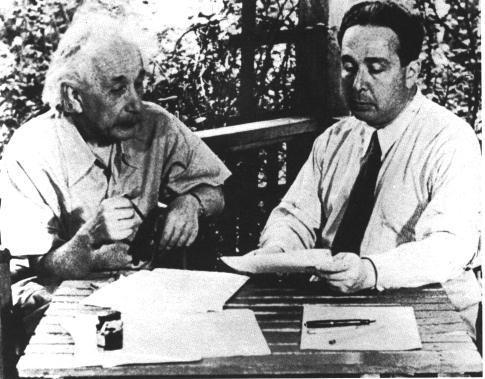
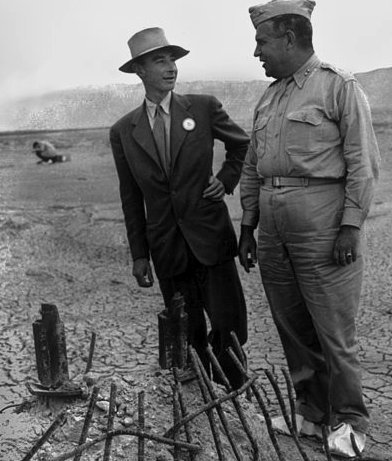
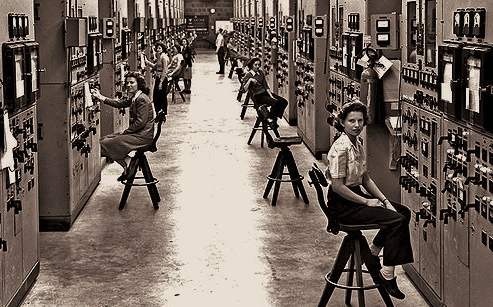
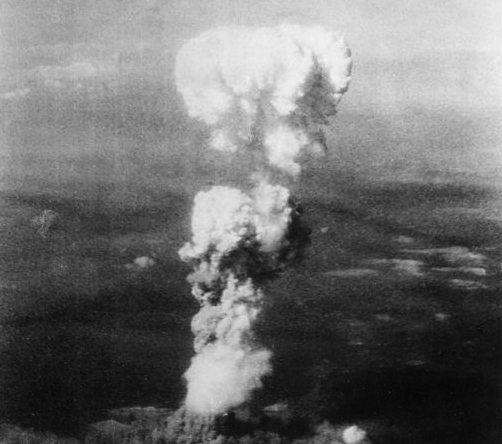
On August 2, 1939, just before the beginning of World War II, Albert Einstein wrote to then President Franklin D. Roosevelt. Einstein and several other scientists told Roosevelt of efforts in Nazi Germany to purify uranium-235, which could be used to build an atomic bomb. It was shortly thereafter that the United States Government began the serious undertaking known then only as "The Manhattan Project." Simply put, the Manhattan Project was committed to expediting research that would produce a viable atomic bomb.
Making Enriched Uranium
The most complicated issue to be addressed in making of an atomic bomb was the production of ample amounts of "enriched" uranium to sustain a chain reaction. At the time, uranium-235 was very hard to extract. In fact, the ratio of conversion from uranium ore to uranium metal is 500:1. Compounding this, the one part of uranium that is finally refined from the ore is over 99% uranium-238, which is practically useless for an atomic bomb. To make the task even more difficult, the useful U-235 and nearly useless U-238 are isotopes, nearly identical in their chemical makeup. No ordinary chemical extraction method could separate them; only mechanical methods could work.
A massive enrichment laboratory/plant was constructed at Oak Ridge, Tennessee. Harold Urey and his colleagues at Columbia University devised an extraction system that worked on the principle of gaseous diffusion, and Ernest Lawrence (inventor of the Cyclotron) at the University of California in Berkeley implemented a process involving magnetic separation of the two isotopes.
Next, a gas centrifuge was used to further separate the lighter U-235 from the heavier, non-fissionable U-238. Once all of these procedures had been completed, all that needed to be done was to put to the test the entire concept behind atomic fission ("splitting the atom," in layman's terms).
Robert Oppenheimer - Manhattan Project
Over the course of six years, from 1939 to 1945, more than $2 billion was spent during the history of the Manhattan Project. The formulas for refining uranium and putting together a working atomic bomb were created and seen to their logical ends by some of the greatest minds of our time. Chief among the people who unleashed the power of the atom was Robert Oppenheimer, who oversaw the project from conception to completion.
Testing The Gadget aka Atomic Bomb
Finally, the day came when all at Los Alamos would find out if "The Gadget" (code-named as such during its development) was going to be the colossal dud of the century or perhaps an end to the war. It all came down to a fateful morning in midsummer, 1945.
At 5:29:45 (Mountain War Time) on July 16, 1945, in a white blaze that stretched from the basin of the Jemez Mountains in northern New Mexico to the still-dark skies, "The Gadget" ushered in the Atomic Age. The light of the explosion then turned orange as the atomic fireball began shooting upwards at 360 feet per second, reddening and pulsing as it cooled. The characteristic mushroom cloud of radioactive vapor materialized at 30,000 feet. Beneath the cloud, all that remained of the soil at the blast site were fragments of jade green radioactive glass created by the heat of the reaction.
The brilliant light from the detonation pierced the early morning skies with such intensity that residents from a faraway neighboring community would swear that the sun came up twice that day. Even more astonishing is that a blind girl saw the flash 120 miles away.
Key Staff - Manhattan Project
Scientists Who Invented the Atomic Bomb under the Manhattan Project: Robert Oppenheimer, David Bohm, Leo Szilard, Eugene Wigner, Otto Frisch, Rudolf Peierls, Felix Bloch, Niels Bohr, Emilio Segre, James Franck, Enrico Fermi, Klaus Fuchs and Edward Teller.
(Source:http://inventors.about.com/od/astarti...)
More:
http://inventors.about.com/od/astarti...
http://en.wikipedia.org/wiki/Manhatta...
http://www.atomicarchive.com/History/mp/
http://energy.gov/management/download...
http://www.historylearningsite.co.uk/...
http://www.losalamoshistory.org/manha...
http://www.brainpickings.org/index.ph...
http://www.ourdocuments.gov/doc.php?f...
http://www.dailymail.co.uk/news/artic...

 by
by
 Richard Rhodes
Richard Rhodes
 by Michael B. Stoff (no photo)
by Michael B. Stoff (no photo)
 by
by
 Kai Bird
Kai Bird
 by
by
 Denise Kiernan
Denise Kiernan
 by Ruth Howes (no photo)
by Ruth Howes (no photo)




On August 2, 1939, just before the beginning of World War II, Albert Einstein wrote to then President Franklin D. Roosevelt. Einstein and several other scientists told Roosevelt of efforts in Nazi Germany to purify uranium-235, which could be used to build an atomic bomb. It was shortly thereafter that the United States Government began the serious undertaking known then only as "The Manhattan Project." Simply put, the Manhattan Project was committed to expediting research that would produce a viable atomic bomb.
Making Enriched Uranium
The most complicated issue to be addressed in making of an atomic bomb was the production of ample amounts of "enriched" uranium to sustain a chain reaction. At the time, uranium-235 was very hard to extract. In fact, the ratio of conversion from uranium ore to uranium metal is 500:1. Compounding this, the one part of uranium that is finally refined from the ore is over 99% uranium-238, which is practically useless for an atomic bomb. To make the task even more difficult, the useful U-235 and nearly useless U-238 are isotopes, nearly identical in their chemical makeup. No ordinary chemical extraction method could separate them; only mechanical methods could work.
A massive enrichment laboratory/plant was constructed at Oak Ridge, Tennessee. Harold Urey and his colleagues at Columbia University devised an extraction system that worked on the principle of gaseous diffusion, and Ernest Lawrence (inventor of the Cyclotron) at the University of California in Berkeley implemented a process involving magnetic separation of the two isotopes.
Next, a gas centrifuge was used to further separate the lighter U-235 from the heavier, non-fissionable U-238. Once all of these procedures had been completed, all that needed to be done was to put to the test the entire concept behind atomic fission ("splitting the atom," in layman's terms).
Robert Oppenheimer - Manhattan Project
Over the course of six years, from 1939 to 1945, more than $2 billion was spent during the history of the Manhattan Project. The formulas for refining uranium and putting together a working atomic bomb were created and seen to their logical ends by some of the greatest minds of our time. Chief among the people who unleashed the power of the atom was Robert Oppenheimer, who oversaw the project from conception to completion.
Testing The Gadget aka Atomic Bomb
Finally, the day came when all at Los Alamos would find out if "The Gadget" (code-named as such during its development) was going to be the colossal dud of the century or perhaps an end to the war. It all came down to a fateful morning in midsummer, 1945.
At 5:29:45 (Mountain War Time) on July 16, 1945, in a white blaze that stretched from the basin of the Jemez Mountains in northern New Mexico to the still-dark skies, "The Gadget" ushered in the Atomic Age. The light of the explosion then turned orange as the atomic fireball began shooting upwards at 360 feet per second, reddening and pulsing as it cooled. The characteristic mushroom cloud of radioactive vapor materialized at 30,000 feet. Beneath the cloud, all that remained of the soil at the blast site were fragments of jade green radioactive glass created by the heat of the reaction.
The brilliant light from the detonation pierced the early morning skies with such intensity that residents from a faraway neighboring community would swear that the sun came up twice that day. Even more astonishing is that a blind girl saw the flash 120 miles away.
Key Staff - Manhattan Project
Scientists Who Invented the Atomic Bomb under the Manhattan Project: Robert Oppenheimer, David Bohm, Leo Szilard, Eugene Wigner, Otto Frisch, Rudolf Peierls, Felix Bloch, Niels Bohr, Emilio Segre, James Franck, Enrico Fermi, Klaus Fuchs and Edward Teller.
(Source:http://inventors.about.com/od/astarti...)
More:
http://inventors.about.com/od/astarti...
http://en.wikipedia.org/wiki/Manhatta...
http://www.atomicarchive.com/History/mp/
http://energy.gov/management/download...
http://www.historylearningsite.co.uk/...
http://www.losalamoshistory.org/manha...
http://www.brainpickings.org/index.ph...
http://www.ourdocuments.gov/doc.php?f...
http://www.dailymail.co.uk/news/artic...

 by
by
 Richard Rhodes
Richard Rhodes by Michael B. Stoff (no photo)
by Michael B. Stoff (no photo) by
by
 Kai Bird
Kai Bird by
by
 Denise Kiernan
Denise Kiernan by Ruth Howes (no photo)
by Ruth Howes (no photo)
Omar Bradley
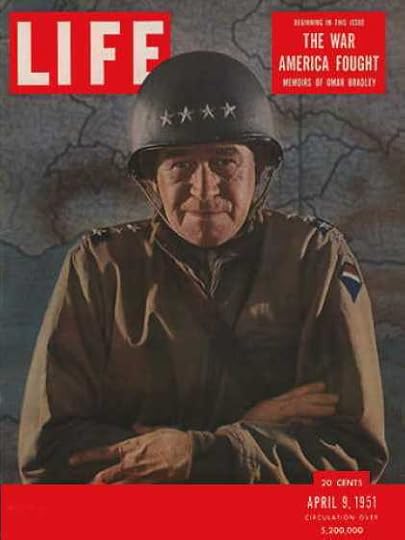
Omar Nelson Bradley (February 12, 1893 - April 8, 1981) was one of the main US Army field commanders in North Africa and Europe during World War II.
Bradley was born to a poor family Clark, Missouri, the son of a schoolteacher. He was educated at local schools and intended to enter the University of Missouri. Instead, he was advised to try for West Point. He placed first in his district exams for a place and entered the academy in 1911. He gradated from West Point in 1915 as part of a class that contained many future generals, which military historians have called, "The class the stars fell upon."
He joined the 14th Infantry Regiment but, like many of his peers, did not see action in Europe, but held a variety of stateside assignments. He served on the Mexican border in 1915. When war was declared, he was promoted to captain, but was posted to Montana. Bradley joined the 19th Infantry Division in August 1918.
Between the wars he taught and studied. From 1920-24 he taught mathematics at West Point. He was promoted to a major in 1924 and took the advanced infantry course at Fort Benning, Georgia. After a brief service in Hawaii he then studied at the Command and General Staff School at Fort Leavenworth in 1928-29. From 1929 he taught at West Point again, taking a break to study at the Army War College in 1934. He was promoted to lieutenant colonel in 1936 and worked at the War Department from 1938. In February 1941 he was promoted to brigadier general and sent to command Fort Benning. In February 1942 he took command of the 82nd Infantry Division before being switched to the 28th Infantry Division in June.
Bradley did not receive a frontline command until early 1943 after Operation Torch. He had been given VIII Corps but instead was sent to North Africa to serve under Dwight D. Eisenhower. He became head of II Corps in April and directed them in the final battles of April and May. He then led his corps onto Sicily in July. During Operation Overlord he commanded three corps directed at the areas codenamed Utah and Omaha. Later in July he planned Operation Cobra which was the beginning of the breakout from the Normandy beachhead. By August, Bradley's command, the renamed 12th Army Group, had swollen to over 900,000 men.
Bradley used his force to undertake an ambitious plan to encircle the German forces in Normandy, trapping them at the Chambois pocket. It was only partially successful but German forces still suffered huge losses during their retreat. The American forces reached the 'Siegfried Line' or 'Westwall' in late September. The sheer scale of the advance had taken the Allied high command by surprise. They had expected the German Wehrmacht to make stands on the natural defensive lines provided by the French rivers, and consequently, logistics had become a severe issue as well.
At this time, the Allied high command under Eisenhower faced a decision on strategy. Bradley favored a strategy consisting of a advance into the Saar, or possibly a two thrust assault on both the Saar and the Ruhr. Newly promoted to Field Marshal, Bernard Montgomery argued that he should lead a thrust on the northern flank into the Ruhr. Montgomery's tempestuous personality ultimately carried the day, leading to Operation Market-Garden. The debate, while not fissuring the Allied command, nevertheless led to a serious rift between the two Army group commanders of the European Theater of Operations.
After the failure of Montgomery's forces to take Arnhem and its bridge across the Rhine, forces under Bradley's command took the initial brunt of what would become the Battle of the Bulge. In a move without precedent in modern warfare, the US 3rd Army under George Patton disengaged from their combat in the Saarland, moved 90 miles to the battlefront, and forced the Germans back. Bradley used the advantage gained in March 1945 — after Eisenhower once again favored Montgomery with supplies for another unsuccessful offensive in February 1945 — to break the German defences and cross the Rhine into the industrial heartland of the Ruhr. Aggressive pursuit of the disintegrating German troops by Bradley's forces resulted in the capture of a bridge across the Rhine River at Remagen. Bradley and his subordinates quickly exploited the crossing, leading to an enormous pincer movement encircling the German forces in the Ruhr from the north and south. Over 300,000 prisoners were taken. American forces then met up with the Soviet forces near the River Elbe in mid-April. By V-E Day, the 12th Army Group was a force of four armies (1st, 3rd, 9th, and 15th) that numbered over 1.3 million men.
Bradley headed the Veterans Administration for two years after the war. He was made army chief of staff in 1948 and first official Chairman of the Joint Chiefs of Staff in 1949. On September 22, 1950 he was promoted to the rank of General of the Army, the fifth man and last, to achieve that rank. Also in 1950 he was made the first Chairman of the NATO Committee. He remained on the committee until August 1953 when he left active duty to take a number of positions in commercial life.
(Source: http://www.biographybase.com/biograph...)
More:
http://en.wikipedia.org/wiki/Omar_Bra...
http://www.arlingtoncemetery.net/omar...
http://shs.umsystem.edu/historicmisso...
http://www.history.army.mil/brochures...
http://militaryhistory.about.com/od/1...
http://www.pbs.org/wgbh/americanexper...
http://www.history.com/topics/omar-br...
http://www.spartacus.schoolnet.co.uk/...
 by Jim DeFelice (no photo)
by Jim DeFelice (no photo)

 by
by
 Omar Nelson Bradley
Omar Nelson Bradley
 by Dale Greenwell (no photo)
by Dale Greenwell (no photo)
 by Jonathan W. Jordan (no photo)
by Jonathan W. Jordan (no photo)

Omar Nelson Bradley (February 12, 1893 - April 8, 1981) was one of the main US Army field commanders in North Africa and Europe during World War II.
Bradley was born to a poor family Clark, Missouri, the son of a schoolteacher. He was educated at local schools and intended to enter the University of Missouri. Instead, he was advised to try for West Point. He placed first in his district exams for a place and entered the academy in 1911. He gradated from West Point in 1915 as part of a class that contained many future generals, which military historians have called, "The class the stars fell upon."
He joined the 14th Infantry Regiment but, like many of his peers, did not see action in Europe, but held a variety of stateside assignments. He served on the Mexican border in 1915. When war was declared, he was promoted to captain, but was posted to Montana. Bradley joined the 19th Infantry Division in August 1918.
Between the wars he taught and studied. From 1920-24 he taught mathematics at West Point. He was promoted to a major in 1924 and took the advanced infantry course at Fort Benning, Georgia. After a brief service in Hawaii he then studied at the Command and General Staff School at Fort Leavenworth in 1928-29. From 1929 he taught at West Point again, taking a break to study at the Army War College in 1934. He was promoted to lieutenant colonel in 1936 and worked at the War Department from 1938. In February 1941 he was promoted to brigadier general and sent to command Fort Benning. In February 1942 he took command of the 82nd Infantry Division before being switched to the 28th Infantry Division in June.
Bradley did not receive a frontline command until early 1943 after Operation Torch. He had been given VIII Corps but instead was sent to North Africa to serve under Dwight D. Eisenhower. He became head of II Corps in April and directed them in the final battles of April and May. He then led his corps onto Sicily in July. During Operation Overlord he commanded three corps directed at the areas codenamed Utah and Omaha. Later in July he planned Operation Cobra which was the beginning of the breakout from the Normandy beachhead. By August, Bradley's command, the renamed 12th Army Group, had swollen to over 900,000 men.
Bradley used his force to undertake an ambitious plan to encircle the German forces in Normandy, trapping them at the Chambois pocket. It was only partially successful but German forces still suffered huge losses during their retreat. The American forces reached the 'Siegfried Line' or 'Westwall' in late September. The sheer scale of the advance had taken the Allied high command by surprise. They had expected the German Wehrmacht to make stands on the natural defensive lines provided by the French rivers, and consequently, logistics had become a severe issue as well.
At this time, the Allied high command under Eisenhower faced a decision on strategy. Bradley favored a strategy consisting of a advance into the Saar, or possibly a two thrust assault on both the Saar and the Ruhr. Newly promoted to Field Marshal, Bernard Montgomery argued that he should lead a thrust on the northern flank into the Ruhr. Montgomery's tempestuous personality ultimately carried the day, leading to Operation Market-Garden. The debate, while not fissuring the Allied command, nevertheless led to a serious rift between the two Army group commanders of the European Theater of Operations.
After the failure of Montgomery's forces to take Arnhem and its bridge across the Rhine, forces under Bradley's command took the initial brunt of what would become the Battle of the Bulge. In a move without precedent in modern warfare, the US 3rd Army under George Patton disengaged from their combat in the Saarland, moved 90 miles to the battlefront, and forced the Germans back. Bradley used the advantage gained in March 1945 — after Eisenhower once again favored Montgomery with supplies for another unsuccessful offensive in February 1945 — to break the German defences and cross the Rhine into the industrial heartland of the Ruhr. Aggressive pursuit of the disintegrating German troops by Bradley's forces resulted in the capture of a bridge across the Rhine River at Remagen. Bradley and his subordinates quickly exploited the crossing, leading to an enormous pincer movement encircling the German forces in the Ruhr from the north and south. Over 300,000 prisoners were taken. American forces then met up with the Soviet forces near the River Elbe in mid-April. By V-E Day, the 12th Army Group was a force of four armies (1st, 3rd, 9th, and 15th) that numbered over 1.3 million men.
Bradley headed the Veterans Administration for two years after the war. He was made army chief of staff in 1948 and first official Chairman of the Joint Chiefs of Staff in 1949. On September 22, 1950 he was promoted to the rank of General of the Army, the fifth man and last, to achieve that rank. Also in 1950 he was made the first Chairman of the NATO Committee. He remained on the committee until August 1953 when he left active duty to take a number of positions in commercial life.
(Source: http://www.biographybase.com/biograph...)
More:
http://en.wikipedia.org/wiki/Omar_Bra...
http://www.arlingtoncemetery.net/omar...
http://shs.umsystem.edu/historicmisso...
http://www.history.army.mil/brochures...
http://militaryhistory.about.com/od/1...
http://www.pbs.org/wgbh/americanexper...
http://www.history.com/topics/omar-br...
http://www.spartacus.schoolnet.co.uk/...
 by Jim DeFelice (no photo)
by Jim DeFelice (no photo)
 by
by
 Omar Nelson Bradley
Omar Nelson Bradley by Dale Greenwell (no photo)
by Dale Greenwell (no photo) by Jonathan W. Jordan (no photo)
by Jonathan W. Jordan (no photo)
The Big Three Conference at Tehran
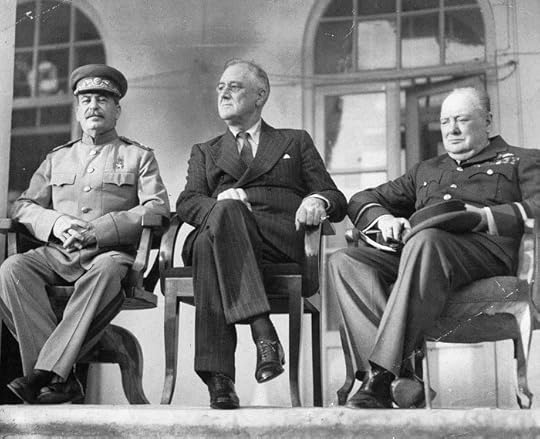
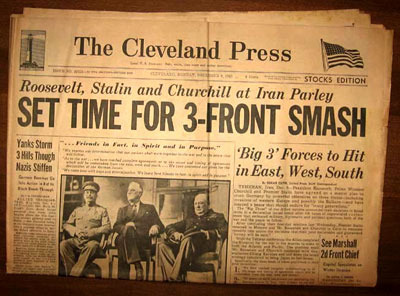
The Tehran Conference (codenamed Eureka was a strategy meeting held between Joseph Stalin, Franklin D. Roosevelt, and Winston Churchill from 28 November to 1 December 1943.
It was held in the Soviet Embassy in Tehran, Iran and was the first of the World War II conferences held between all of the "Big Three" Allied leaders (the Soviet Union, the United States, and the United Kingdom).
It closely followed the Cairo Conference[a] and preceded both the Yalta[b] and Potsdam[c] Conferences.
Although all three of the leaders present arrived with differing objectives, the main outcome of the Tehran Conference was the commitment to the opening of a second front against Nazi Germany by the Western Allies.
The conference also addressed relations between the Allies and Turkey and Iran, operations in Yugoslavia and against Japan as well as the envisaged post-war settlement.
A separate protocol signed at the conference pledged the Big Three's recognition of Iran's independence. (Source: http://en.wikipedia.org/wiki/Tehran_C...)
More:
http://militaryhistory.about.com/od/m...
http://www.historylearningsite.co.uk/...
http://www.pbs.org/behindcloseddoors/...
http://learning.blogs.nytimes.com/201...
http://www.youtube.com/watch?v=93phDN...
http://ww2history.com/key_moments/Wes...
 by Paul D. Mayle (no photo)
by Paul D. Mayle (no photo)
 by
by
 Winston Churchill
Winston Churchill
 by
by
 John Keegan
John Keegan
 by Inter-Allied Conference (no photo)
by Inter-Allied Conference (no photo)
(no image) The Turning Point: Roosevelt, Stalin, Churchill, and Chiang-Kai-Shek, 1943the Moscow, Cairo, and Teheran Conferences by Keith Sainsbury (no photo)


The Tehran Conference (codenamed Eureka was a strategy meeting held between Joseph Stalin, Franklin D. Roosevelt, and Winston Churchill from 28 November to 1 December 1943.
It was held in the Soviet Embassy in Tehran, Iran and was the first of the World War II conferences held between all of the "Big Three" Allied leaders (the Soviet Union, the United States, and the United Kingdom).
It closely followed the Cairo Conference[a] and preceded both the Yalta[b] and Potsdam[c] Conferences.
Although all three of the leaders present arrived with differing objectives, the main outcome of the Tehran Conference was the commitment to the opening of a second front against Nazi Germany by the Western Allies.
The conference also addressed relations between the Allies and Turkey and Iran, operations in Yugoslavia and against Japan as well as the envisaged post-war settlement.
A separate protocol signed at the conference pledged the Big Three's recognition of Iran's independence. (Source: http://en.wikipedia.org/wiki/Tehran_C...)
More:
http://militaryhistory.about.com/od/m...
http://www.historylearningsite.co.uk/...
http://www.pbs.org/behindcloseddoors/...
http://learning.blogs.nytimes.com/201...
http://www.youtube.com/watch?v=93phDN...
http://ww2history.com/key_moments/Wes...
 by Paul D. Mayle (no photo)
by Paul D. Mayle (no photo) by
by
 Winston Churchill
Winston Churchill by
by
 John Keegan
John Keegan by Inter-Allied Conference (no photo)
by Inter-Allied Conference (no photo)(no image) The Turning Point: Roosevelt, Stalin, Churchill, and Chiang-Kai-Shek, 1943the Moscow, Cairo, and Teheran Conferences by Keith Sainsbury (no photo)
Baseball Deferments and World War II
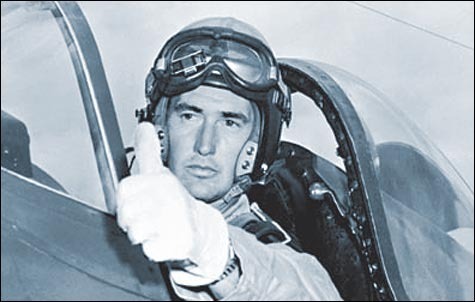
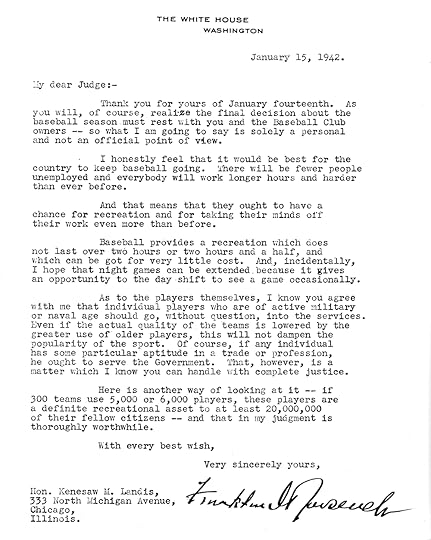
The national pastime played a key role in the American war effort during World War II, and it is a story that has not been fully told.
From the frozen tundra of Iceland to the jungles of the South Pacific; from the deserts of North Africa to the Nazi stadium in Nuremberg, American soldiers, sailors, airmen and Marines played baseball whenever, and wherever, they could.
All told, over 500 major league and more than 2,000 minor league baseball players went into the armed forces. Among the first of these was Bob Feller, the right-handed star pitcher for the Cleveland Indians. Feller was the sole support for his family because his father, an Iowa farmer, was dying of cancer, and because of this he could have easily gotten a deferment. Instead, upon hearing of the Japanese attack on Pearl Harbor, he drove to Chicago and reported to a Navy recruiting office.
“We were losing the war,” Feller said. “We needed heroes.”
Feller subsequently served as a gun captain on board the battleship Alabama and saw action in the Atlantic and then in the Pacific theater, participating in numerous battles. But baseball was not left behind. Feller played baseball and softball in Scotland, Iceland and on numerous islands in the Pacific.
Among the many other baseball stars serving were Stan Musial, Joe DiMaggio, Ted Williams, Warren Spahn, Yogi Berra, Pee Wee Reese, Phil Rizutto and Hank Greenberg. (Source: http://legacy.stripes.com/baseball/ar...)
More:
http://legacy.stripes.com/baseball/ar...
http://legacy.stripes.com/baseball/Ba...
http://legacy.stripes.com/baseball/ar...
http://legacy.stripes.com/baseball/ar...
http://legacy.stripes.com/baseball/ar...
http://legacy.stripes.com/baseball/ar...
http://www.baseballinwartime.com
http://www.americanheritage.com/conte...
 by Steven R. Bullock (no photo)
by Steven R. Bullock (no photo)
(no image) They Also Served: Baseball and the Home Front, 1941-45 by Bill Gilbert (no photo)
 by Donald Wells (no photo)
by Donald Wells (no photo)
 by Leonard Cassuto(no photo)
by Leonard Cassuto(no photo)
 by Todd Anton (no photo)
by Todd Anton (no photo)
(no image) Baseball in World War II Europeby Gary Bedingfield (no photo)


The national pastime played a key role in the American war effort during World War II, and it is a story that has not been fully told.
From the frozen tundra of Iceland to the jungles of the South Pacific; from the deserts of North Africa to the Nazi stadium in Nuremberg, American soldiers, sailors, airmen and Marines played baseball whenever, and wherever, they could.
All told, over 500 major league and more than 2,000 minor league baseball players went into the armed forces. Among the first of these was Bob Feller, the right-handed star pitcher for the Cleveland Indians. Feller was the sole support for his family because his father, an Iowa farmer, was dying of cancer, and because of this he could have easily gotten a deferment. Instead, upon hearing of the Japanese attack on Pearl Harbor, he drove to Chicago and reported to a Navy recruiting office.
“We were losing the war,” Feller said. “We needed heroes.”
Feller subsequently served as a gun captain on board the battleship Alabama and saw action in the Atlantic and then in the Pacific theater, participating in numerous battles. But baseball was not left behind. Feller played baseball and softball in Scotland, Iceland and on numerous islands in the Pacific.
Among the many other baseball stars serving were Stan Musial, Joe DiMaggio, Ted Williams, Warren Spahn, Yogi Berra, Pee Wee Reese, Phil Rizutto and Hank Greenberg. (Source: http://legacy.stripes.com/baseball/ar...)
More:
http://legacy.stripes.com/baseball/ar...
http://legacy.stripes.com/baseball/Ba...
http://legacy.stripes.com/baseball/ar...
http://legacy.stripes.com/baseball/ar...
http://legacy.stripes.com/baseball/ar...
http://legacy.stripes.com/baseball/ar...
http://www.baseballinwartime.com
http://www.americanheritage.com/conte...
 by Steven R. Bullock (no photo)
by Steven R. Bullock (no photo)(no image) They Also Served: Baseball and the Home Front, 1941-45 by Bill Gilbert (no photo)
 by Donald Wells (no photo)
by Donald Wells (no photo) by Leonard Cassuto(no photo)
by Leonard Cassuto(no photo) by Todd Anton (no photo)
by Todd Anton (no photo)(no image) Baseball in World War II Europeby Gary Bedingfield (no photo)
 Casablanca Conference
Casablanca Conference
The Casablanca Conference (codenamed SYMBOL) was held at the Anfa Hotel in Casablanca, Morocco, then a French protectorate, from January 14 to 24, 1943, to plan the Allied European strategy for the next phase of World War II. In attendance were United States President Franklin D. Roosevelt, British Prime Minister Winston Churchill, and representing the Free French forces, Generals Charles de Gaulle, and Henri Giraud. Premier Joseph Stalin had declined to attend, citing the ongoing conflict in Stalingrad required his presence in the Soviet Union. The conference agenda addressed the specifics of tactical procedure, allocation of resources and the broader issues of diplomatic policy. The debate and negotiations produced what was known as the “Casablanca Declaration,” and what is, perhaps, its most historically provocative statement of purpose, “unconditional surrender.” The doctrine of “unconditional surrender” came to represent the unified voice of implacable Allied will—the determination that the Axis powers would be fought to their ultimate defeat and annihilation.
European invasion
Roosevelt, with advise from General George Catlett Marshall, US Army Chief of Staff, and Admiral Ernest King, Chief of Naval Operations, lobbied for a cross channel invasion of Europe. Churchill felt the time was not opportune, and favored an Allied assault on Sicily moving in through Italy. Throughout the conference Roosevelt’s attention was prominently focused on the Pacific war front and faulted the British for what he felt was not a full commitment against Japanese entrenchment. The Italian strategy was agreed upon, a compromise between the two leaders, Roosevelt acceding to the Churchill approach for Europe. Churchill, in turn, pledged more troops and resources to the Pacific and Burma to reinforce positions held by Chiang Kai-Shek against the Japanese. America would provide assistance to the British in the Pacific by supplying escorts and landing craft.
Logistical issues
- next phase of European war
- all possible aid would be provided to the Russian - offensive
- assessment of U-boat danger in the Atlantic
- disposition of ships, planes, troops in the various theatres of war
- Joseph Stalin and Chiang Kai-Shek would be fully apprised of the conference agenda and resulting accords
Leadership of Free French forces
The conference called for the official recognition of a joint leadership of the Free French forces by Charles de Gaulle and Henri Giraud. There was notable tension between the two men during the talks. Roosevelt effected a public cordiality between them, encouraging them to shake hands, demonstrating a mutual affability for the photographers eager for a photo-op. Purportedly, the ritual handshake was done with reluctance and so quickly, they had to pose for a second shoot. During the conference both men limited their interaction with one and other to formalities, each pledging their mutual support.
Post-war northern Africa
During the Conference, Roosevelt spoke with the French resident general at Rabat, Morocco, about postwar independence and Jewish immigrants in North Africa. Roosevelt proposed that:
"[t]he number of Jews engaged in the practice of the professions (law, medicine, etc.) should be definitely limited to the percentage that the Jewish population in North Africa bears to the whole of the North African population.... [T]his plan would further eliminate the specific and understandable complaints which the Germans bore towards the Jews in Germany, namely, that while they represented a small part of the population, over 50 percent of the lawyers, doctors, schoolteachers, college professors, etc., in Germany were Jews."
This disposition of the Jewish population harkened back to a mindset communicated in earlier years to Roosevelt by the American ambassador to Germany, William Dodd (1933-1937). Dodd had appraised Germany’s repression of Jews, and writing to Roosevelt, he parroted the Nazi propaganda: “The Jews had held a great many more of the key positions in Germany than their number or talents entitled them to.”
Roosevelt presented the results of the conference to the American people in a radio address on February 12, 1943.
Legacy
The consequences of crucial policy made in 1943 have over the years been subjected to critical examination and re-evaluation. It has been posited that decisions made at Casablanca unnecessarily prolonged the war in Europe and needlessly increased combat and civilian casualties. It also is believed that Allied military strategy subsequently facilitated the Soviet occupation of eastern Germany and the Communist take-over of Eastern Europe. The status of Great Britain as a world power was diminished: “After Casablanca, the US would start to act as the senior partner in the alliance.”
(Source: http://en.wikipedia.org/wiki/Casablan...)
More:
http://en.wikipedia.org/wiki/Total_wa...
http://www.bbc.co.uk/history/ww2peopl...
http://ww2today.com/24th-january-1943...
http://fdrlibrary.wordpress.com/tag/c...
http://history.state.gov/milestones/1...
http://avalon.law.yale.edu/wwii/casab...
http://www.nisk.k12.ny.us/fdr/ideas/p...
http://ww2db.com/battle_spec.php?batt...
http://www.nytimes.com/learning/gener...
 by Mark A. Stoler (no photo)
by Mark A. Stoler (no photo) by David J Stone (no photo)
by David J Stone (no photo) by Inter-Allied Conference (no photo)
by Inter-Allied Conference (no photo) by Books LLC (no photo)
by Books LLC (no photo) by Kevin Smith (no photo)
by Kevin Smith (no photo)
 Unconditional Surrender
Unconditional Surrender
On the 24th January 1943 Prime Minister Winston Churchill and President Franklin D. Roosevelt held a secret Press conference at the conclusion of their meeting in Casablanca. The notion of such an arrangement is unthinkable today but the Press agreed not to release their material until both Churchill and Roosevelt were both safely away from Casablanca.
Some of the key decisions for the future conduct of the war had been thrashed out between the Allies. One matter was the demand for ‘unconditional surrender’ – a proposition which some have later argued made any possible early negotiated end to the war out of the question.
There was some surprise that President Roosevelt announced that the Allies would be seeking unconditional surrender from the Axis forces. There was subsequently some suggestion that he made the proposal ‘off the top of his head’ during the Press conference but this is clearly not the case.
Winston Churchill had already been in communication with the War Cabinet in London about the issue:
"We propose to draw up a statement of the work of the conference for communication to the Press at the proper time. I should be glad to know what the War Cabinet would think of our including in this statement a declaration of the firm intention of the United States and the British Empire to continue the war relentlessly until we have brought about the “unconditional surrender” of Germany and Japan. The omission of Italy would be to encourage a break-up there. The President liked this idea, and it would stimulate our friends in every country."
The War Cabinet had responded to him on the 20th January, stating that they did not think Italy should not be excluded. Churchill seems to have believed that the matter would be further discussed but both he and Roosevelt were became very occupied whilst dealing with General de Gaulle.
"It seems probable that as I did not like applying unconditional surrender to Italy I did not raise the point again with the President, and we had certainly both agreed to the communiqué we had settled with our advisers. There is no mention in it of “unconditional surrender”."
So the matter had been under discussion but it had not been part of the joint communique that Britain and America had agreed in advance.
"It was with some feeling of surprise that I heard the President say at the Press Conference on January 24 that we would enforce “unconditional surrender” upon all our enemies. It was natural to suppose that the agreed communiqué had superseded anything said in conversation. General Ismay, who knew exactly how my mind was working from day to day, and was also present at all the discussions of the Chiefs of Staff when the Communiqué was prepared, was also surprised.
In my speech which followed the President’s I of course supported him and concurred in what he had said. Any divergence between us, even by omission, would on such an occasion and at such a time have been damaging or even dangerous to our war effort. I certainly take my share of the responsibility, together with the British War Cabinet."
The President’s account to Hopkins seems however conclusive.
“We had so much trouble getting those two French generals together that I thought to myself that this was as difficult as arranging the meeting of Grant and Lee – and then suddenly the Press Conference was on, and Winston and I had had no time to prepare for it, and the thought popped into my mind that they had called Grant “Old Unconditional Surrender”, and the next thing I knew I had said it.”
I do not feel that this frank statement is in any way weakened by the fact that the phrase occurs in the notes from which he spoke.
(Source: http://ww2today.com/24th-january-1943...)
More:
http://en.wikipedia.org/wiki/Total_wa...
http://en.wikipedia.org/wiki/Casablan...
http://ww.hnn.us/articles/204.html
http://www.commandposts.com/2013/01/u...
http://www.worldfuturefund.org/wffmas...
 by
by
 Thomas J. Fleming
Thomas J. Fleming by Agostino Von Hassell (no photo)
by Agostino Von Hassell (no photo)Unconditional Surrender: The Impact of the Casablanca Policy Upon World War II (no cover) by Anne Armstrong (no photo)
 by Walter Ludde-Neurath (no photo)
by Walter Ludde-Neurath (no photo)Japan's Decision to Surrender (no cover) by Robert J.C. Butow (no photo)
Usher L. Burdick
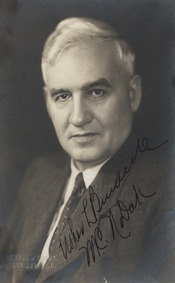
Usher Burdick was born in Owatonna, Minnesota, on 21st February, 1879. His family moved to Graham's Island, Dakota Territory and was raised among the Sioux Indians.
In 1900 Burdick became deputy superintendent of schools of Benson County, North Dakota. He also attended the University of Minnesota and was admitted to the bar in 1904.
A member of the Republican Party, Burdick served in the Minnesota House of Representatives (1907-1911). Burdick was also the attorney of Williams County (1913-1915) and assistant district attorney for North Dakota (1929-1932).
Burdick was elected to Congress in November 1934. Over the next few years he played a leading role in the campaign to free Tom Mooney and Warren Billings. Burdick served ten terms in Congress (January, 1935 to January, 1945 and January, 1949 and January, 1959). Usher Burdick died in Washington on 19th August, 1960.
(Source: http://www.spartacus.schoolnet.co.uk/...)
More:
http://en.wikipedia.org/wiki/Usher_L....
http://bioguide.congress.gov/scripts/...
http://webapp.und.edu/dept/library/Co...
http://www.nndb.com/people/120/000208...
http://wpmedianetwork.com/audio/205/U...
http://news.google.com/newspapers?nid...
http://www.time.com/time/magazine/art...
 by William D. Pederson (no photo)
by William D. Pederson (no photo)
 by Usher L. Burdick (no photo)
by Usher L. Burdick (no photo)
 by Elwyn B. Robinson (no photo)
by Elwyn B. Robinson (no photo)
(no image) North Dakota: A Bicentennial History by Wynona H. Wilkins (no photo)
(no image) Prairie Populist: The Life and Times of Usher L. Burdick by Edward Converse Blackorby (no photo)

Usher Burdick was born in Owatonna, Minnesota, on 21st February, 1879. His family moved to Graham's Island, Dakota Territory and was raised among the Sioux Indians.
In 1900 Burdick became deputy superintendent of schools of Benson County, North Dakota. He also attended the University of Minnesota and was admitted to the bar in 1904.
A member of the Republican Party, Burdick served in the Minnesota House of Representatives (1907-1911). Burdick was also the attorney of Williams County (1913-1915) and assistant district attorney for North Dakota (1929-1932).
Burdick was elected to Congress in November 1934. Over the next few years he played a leading role in the campaign to free Tom Mooney and Warren Billings. Burdick served ten terms in Congress (January, 1935 to January, 1945 and January, 1949 and January, 1959). Usher Burdick died in Washington on 19th August, 1960.
(Source: http://www.spartacus.schoolnet.co.uk/...)
More:
http://en.wikipedia.org/wiki/Usher_L....
http://bioguide.congress.gov/scripts/...
http://webapp.und.edu/dept/library/Co...
http://www.nndb.com/people/120/000208...
http://wpmedianetwork.com/audio/205/U...
http://news.google.com/newspapers?nid...
http://www.time.com/time/magazine/art...
 by William D. Pederson (no photo)
by William D. Pederson (no photo) by Usher L. Burdick (no photo)
by Usher L. Burdick (no photo) by Elwyn B. Robinson (no photo)
by Elwyn B. Robinson (no photo)(no image) North Dakota: A Bicentennial History by Wynona H. Wilkins (no photo)
(no image) Prairie Populist: The Life and Times of Usher L. Burdick by Edward Converse Blackorby (no photo)
Quebec Conference 1 and 2
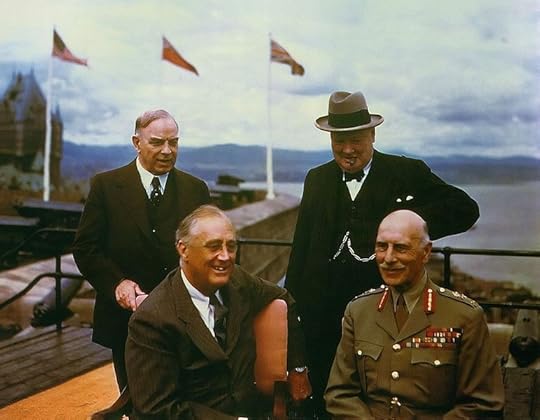
Quebec Conference, 1943
The First Quebec Conference (codenamed "QUADRANT") was a highly secret military conference held during World War II between the British, Canadian and United States governments.
The conference was held in Quebec City, August 17, 1943 – August 24, 1943. It took place at the Citadelle and at the Château Frontenac.
The chief representatives were Winston Churchill and Franklin D. Roosevelt, hosted by Canada's prime minister, William Lyon Mackenzie King.
The allies agreed to begin discussions for the planning of the invasion of France, codenamed Overlord in a secret report by the Combined Chiefs of Staff. There were also discussions to increase the bombing offensive against Germany and continue the buildup of American forces in Britain prior to an invasion of France.
In the Mediterranean (a theatre on which Churchill was very keen) they resolved to concentrate more force to remove Italy from the alliance of Axis Powers and to occupy it along with Corsica.
There were discussions about improving the coordination of efforts by the Americans, British and Canadians to develop an atomic bomb.
It was decided that operations in the Balkans should be limited to supplying guerrillas whereas operations against Japan would be intensified in order to exhaust Japanese resources, cut their communications lines and secure forward bases from which the Japanese mainland could be attacked.
In addition to the strategic discussions, which were communicated to the Soviet Union and to Chiang Kai-Shek in China, the conference also issued a joint statement on Palestine, intended to calm tensions as the British occupation was becoming increasingly untenable. The conference also condemned German atrocities in Poland.
Churchill and Roosevelt also secretly signed the Quebec Agreement to share nuclear technology.
Following the conference, Churchill holidayed at a fishing camp and then, on August 31, 1943, delivered a radio address before traveling by special train to Washington, D.C. to resume talks with Roosevelt.
Quebec Conference, 1944
The Second Quebec Conference (codenamed "OCTAGON") was a high-level military conference held during World War II by the British, Canadian and American governments.
The conference was held in Quebec City, September 12, 1944 - September 16, 1944, and was the second conference to be held in Quebec, after "QUADRANT" in August 1943. The chief representatives were Winston Churchill, William Lyon Mackenzie King and Franklin D. Roosevelt.
Agreements were reached on the following topics: Allied occupation zones in defeated Germany, the Morgenthau Plan, continued U.S. economic aid to the United Kingdom, and UK naval participation in the conflict against Japan. It helped the Allied powers devise a plan to win the war.
(Sources: http://en.wikipedia.org/wiki/Quebec_C... and http://en.wikipedia.org/wiki/Second_Q...)
More:
http://www.cbc.ca/archives/categories...
http://news.google.com/newspapers?id=...
http://news.google.com/newspapers?id=...
http://news.google.com/newspapers?id=...
http://www.winstonchurchill.org/learn...
http://ms.radio-canada.ca/archives_ne...
http://www.pbs.org/behindcloseddoors/...
http://www.bbc.co.uk/history/ww2peopl...
http://avalon.law.yale.edu/subject_me...
http://avalon.law.yale.edu/20th_centu...
(no image)America's Failure in China: 1941-1950, Vol. 2 by Tang Tsou (no photo)
 by
by
 David Irving
David Irving
 by John L. Snell (no photo)
by John L. Snell (no photo)
 by David B. Woolner (no photo)
by David B. Woolner (no photo)
 by Randall Bennett Woods (no photo)
by Randall Bennett Woods (no photo)

Quebec Conference, 1943
The First Quebec Conference (codenamed "QUADRANT") was a highly secret military conference held during World War II between the British, Canadian and United States governments.
The conference was held in Quebec City, August 17, 1943 – August 24, 1943. It took place at the Citadelle and at the Château Frontenac.
The chief representatives were Winston Churchill and Franklin D. Roosevelt, hosted by Canada's prime minister, William Lyon Mackenzie King.
The allies agreed to begin discussions for the planning of the invasion of France, codenamed Overlord in a secret report by the Combined Chiefs of Staff. There were also discussions to increase the bombing offensive against Germany and continue the buildup of American forces in Britain prior to an invasion of France.
In the Mediterranean (a theatre on which Churchill was very keen) they resolved to concentrate more force to remove Italy from the alliance of Axis Powers and to occupy it along with Corsica.
There were discussions about improving the coordination of efforts by the Americans, British and Canadians to develop an atomic bomb.
It was decided that operations in the Balkans should be limited to supplying guerrillas whereas operations against Japan would be intensified in order to exhaust Japanese resources, cut their communications lines and secure forward bases from which the Japanese mainland could be attacked.
In addition to the strategic discussions, which were communicated to the Soviet Union and to Chiang Kai-Shek in China, the conference also issued a joint statement on Palestine, intended to calm tensions as the British occupation was becoming increasingly untenable. The conference also condemned German atrocities in Poland.
Churchill and Roosevelt also secretly signed the Quebec Agreement to share nuclear technology.
Following the conference, Churchill holidayed at a fishing camp and then, on August 31, 1943, delivered a radio address before traveling by special train to Washington, D.C. to resume talks with Roosevelt.
Quebec Conference, 1944
The Second Quebec Conference (codenamed "OCTAGON") was a high-level military conference held during World War II by the British, Canadian and American governments.
The conference was held in Quebec City, September 12, 1944 - September 16, 1944, and was the second conference to be held in Quebec, after "QUADRANT" in August 1943. The chief representatives were Winston Churchill, William Lyon Mackenzie King and Franklin D. Roosevelt.
Agreements were reached on the following topics: Allied occupation zones in defeated Germany, the Morgenthau Plan, continued U.S. economic aid to the United Kingdom, and UK naval participation in the conflict against Japan. It helped the Allied powers devise a plan to win the war.
(Sources: http://en.wikipedia.org/wiki/Quebec_C... and http://en.wikipedia.org/wiki/Second_Q...)
More:
http://www.cbc.ca/archives/categories...
http://news.google.com/newspapers?id=...
http://news.google.com/newspapers?id=...
http://news.google.com/newspapers?id=...
http://www.winstonchurchill.org/learn...
http://ms.radio-canada.ca/archives_ne...
http://www.pbs.org/behindcloseddoors/...
http://www.bbc.co.uk/history/ww2peopl...
http://avalon.law.yale.edu/subject_me...
http://avalon.law.yale.edu/20th_centu...
(no image)America's Failure in China: 1941-1950, Vol. 2 by Tang Tsou (no photo)
 by
by
 David Irving
David Irving by John L. Snell (no photo)
by John L. Snell (no photo) by David B. Woolner (no photo)
by David B. Woolner (no photo) by Randall Bennett Woods (no photo)
by Randall Bennett Woods (no photo)
Chiang Kai-shek
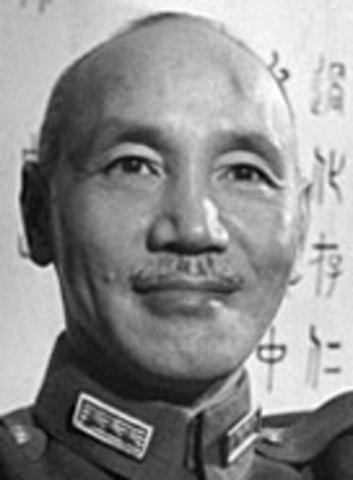
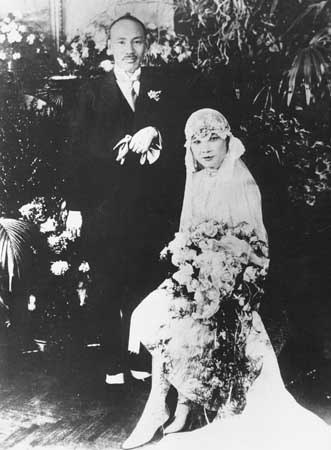
Chiang Kai-shek was a Chinese military and political leader who led the Kuomintang (Chinese Nationalist Party) for five decades and was head of state of the Chinese Nationalist government between 1928 and 1949.
Chiang Kai-shek (also known as Jiang Jieshi) was born on 31 October 1887 in Zhejiang, an eastern coastal province of China. His father was a merchant. At the age of 18 he went to military training college in Japan. He returned to China in 1911 to take part in the uprising that overthrew the Qing Dynasty and established a Chinese republic. Chiang became a member of the Chinese Nationalist Party (known as the Kuomintang or KMT), founded by Sun Yat-sen.
Supported by Sun Yat-sen, Chiang was appointed commandant of the Whampoa Military Academy in Canton in 1924, where he built up the Nationalist army. After Sun's death in 1925, Chiang became leader of the KMT. He spearheaded the Northern Expedition which reunified most of China under a National Government based in Nanjing. In 1928, he led the suppression of the Chinese Communist Party.
Chiang oversaw a modest programme of reform in China but the government's resources were focused on fighting internal opponents, including the Communists. From 1931, Chiang also had to contend with a Japanese invasion in Manchuria, in the north-east of China.
In 1937, Japan launched a full-scale invasion of China. When the United States came into the war against Japan in 1941, China became one of the Allied Powers. As Chiang's position within China weakened, his status abroad grew and in November 1943 he travelled to Cairo to meet US President Franklin D Roosevelt and British Prime Minister Winston Churchill. His wife, Soong Mei-ling, travelled with him and became famous in the west as Madame Chiang.
In 1946, civil war broke out between the KMT and the Communists. In 1949, the Communists were victorious, establishing the People's Republic of China. Chiang and the remaining KMT forces fled to the island of Taiwan. There Chiang established a government in exile which he led for the next 25 years. This government continued to be recognised by many countries as the legitimate government of China, and Taiwan controlled China's seat in the United Nations until the end of Chiang's life. He died on 5 April 1975.
(Source: http://www.bbc.co.uk/history/historic...)
More:
http://en.wikipedia.org/wiki/Chiang_K...
http://www.spartacus.schoolnet.co.uk/...
http://www.history.com/topics/chiang-...
http://www.britannica.com/EBchecked/t...
http://www.time.com/time/world/articl...
http://www.hoover.org/library-and-arc...
http://www.cksmh.gov.tw/eng/
http://www.nytimes.com/learning/gener...
http://www.abookaboutchina.com/biogra...
http://watch.thirteen.org/video/14090...
 by Jay Taylor (no photo)
by Jay Taylor (no photo)
 by Jonathan Fenby (no photo)
by Jonathan Fenby (no photo)
 by
by
 Brian Crozier
Brian Crozier
(no image) Duel for the Middle Kingdom: The Struggle Between Chiang Kai-Shek and Mao Tse-Tung for Control of China by William Morwood (no photo)
(no image) Nationalist China at War: Military Defeats and Political Collapse, 1937-45 by Hsi-Sheng Chi (no photo)
(no image) Strong Man Of China; The Story Of Chiang Kai ShekRobert Berkov (no photo)
 by Hannah Pakula (no photo)
by Hannah Pakula (no photo)


Chiang Kai-shek was a Chinese military and political leader who led the Kuomintang (Chinese Nationalist Party) for five decades and was head of state of the Chinese Nationalist government between 1928 and 1949.
Chiang Kai-shek (also known as Jiang Jieshi) was born on 31 October 1887 in Zhejiang, an eastern coastal province of China. His father was a merchant. At the age of 18 he went to military training college in Japan. He returned to China in 1911 to take part in the uprising that overthrew the Qing Dynasty and established a Chinese republic. Chiang became a member of the Chinese Nationalist Party (known as the Kuomintang or KMT), founded by Sun Yat-sen.
Supported by Sun Yat-sen, Chiang was appointed commandant of the Whampoa Military Academy in Canton in 1924, where he built up the Nationalist army. After Sun's death in 1925, Chiang became leader of the KMT. He spearheaded the Northern Expedition which reunified most of China under a National Government based in Nanjing. In 1928, he led the suppression of the Chinese Communist Party.
Chiang oversaw a modest programme of reform in China but the government's resources were focused on fighting internal opponents, including the Communists. From 1931, Chiang also had to contend with a Japanese invasion in Manchuria, in the north-east of China.
In 1937, Japan launched a full-scale invasion of China. When the United States came into the war against Japan in 1941, China became one of the Allied Powers. As Chiang's position within China weakened, his status abroad grew and in November 1943 he travelled to Cairo to meet US President Franklin D Roosevelt and British Prime Minister Winston Churchill. His wife, Soong Mei-ling, travelled with him and became famous in the west as Madame Chiang.
In 1946, civil war broke out between the KMT and the Communists. In 1949, the Communists were victorious, establishing the People's Republic of China. Chiang and the remaining KMT forces fled to the island of Taiwan. There Chiang established a government in exile which he led for the next 25 years. This government continued to be recognised by many countries as the legitimate government of China, and Taiwan controlled China's seat in the United Nations until the end of Chiang's life. He died on 5 April 1975.
(Source: http://www.bbc.co.uk/history/historic...)
More:
http://en.wikipedia.org/wiki/Chiang_K...
http://www.spartacus.schoolnet.co.uk/...
http://www.history.com/topics/chiang-...
http://www.britannica.com/EBchecked/t...
http://www.time.com/time/world/articl...
http://www.hoover.org/library-and-arc...
http://www.cksmh.gov.tw/eng/
http://www.nytimes.com/learning/gener...
http://www.abookaboutchina.com/biogra...
http://watch.thirteen.org/video/14090...
 by Jay Taylor (no photo)
by Jay Taylor (no photo) by Jonathan Fenby (no photo)
by Jonathan Fenby (no photo) by
by
 Brian Crozier
Brian Crozier(no image) Duel for the Middle Kingdom: The Struggle Between Chiang Kai-Shek and Mao Tse-Tung for Control of China by William Morwood (no photo)
(no image) Nationalist China at War: Military Defeats and Political Collapse, 1937-45 by Hsi-Sheng Chi (no photo)
(no image) Strong Man Of China; The Story Of Chiang Kai ShekRobert Berkov (no photo)
 by Hannah Pakula (no photo)
by Hannah Pakula (no photo)
 Father Edward Coughlin
Father Edward Coughlin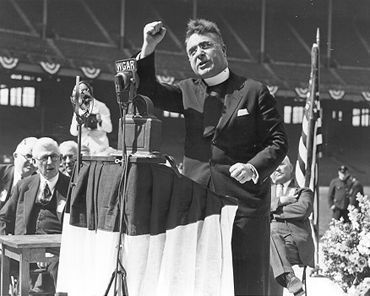
Charles Coughlin (1891–1979) was born on October 25, 1891, in Hamilton, Ontario, Canada. Coughlin graduated from the University of Toronto in 1911. He then attended St. Basil's Seminary in Toronto, and was ordained as a Catholic priest in 1916.
Coughlin's Background and Views
Coughlin's views as a priest were influenced by late eighteenth century Catholic teachings emphasizing conservative clerical activism. His views were also shaped by the Basilian Order to which he belonged. Founded in France in the early nineteenth century, the Basilians studied medieval church doctrine in the context of fierce opposition to modern economic and social developments. They believed that the Church should return to its theological roots and, among other issues, restore the prohibition against usury, which many Basilians regarded as a main source of the ills that afflicted modern society.
Such views would blend with antisemitism in Coughlin's radio broadcasts throughout his career. In a 1930 broadcast, Coughlin attributed the current economic problems on those who profited from usury stating, “We have lived to see the day that modern Shylocks have grown fat and wealthy, praised and defied, because they have perpetuated the ancient crime of usury under the modern racket of statesmanship.”
Coughlin left the Basilian Order in 1918 and became a diocesan priest under the diocese of Detroit.From 1916 to 1923, Coughlin was on the faculty at Assumption College in Sandwich (now Windsor), Ontario, Canada. After a chance meeting with Michael Gallagher, the bishop of the diocese of Detroit, he was given the opportunity to establish a new parish in Royal Oak, Michigan—the Shrine of the Little Flower. This church served as the center of Coughlin's operations for the next forty years.
In October 1926, Coughlin broadcast his first radio address. Originally his broadcasts taught catechism classes for children, but he soon moved on to broadcasting religious services with political overtones. By the time of the 1929 stock market crash, Coughlin had a large, loyal audience and had gained the reputation of a spokesperson for the “common man.” In 1930, he launched a crusade against communism, drawing upon his own fear and that of others that a communist influence was spreading throughout the United States.
Coughlin And Franklin D. Roosevelt
Having become a US citizen while in Detroit, Coughlin was an early and enthusiastic supporter of Franklin D. Roosevelt. He believed that only Roosevelt could pull the United States out of the Depression and, at the same time, protect the country from the perceived communist threat. Coughlin used his radio program—The Hour of Power—to induce his followers to vote for Roosevelt in the 1932 presidential elections. Roosevelt was distrustful of Coughlin from the beginning and only wanted his endorsement to help get elected.
Once president, however, Roosevelt appeared to ignore Coughlin's contribution to getting him elected, and slowly distanced his administration from Coughlin's rough-hewn populism. Roosevelt managed to charm Coughlin into overestimating his importance to the administration, and continued to use Coughlin's influence to help garner public support for the New Deal. As he did during the election, Coughlin used his radio program to support the New Deal and to attack those opposed to it. When he realized that he was not going to play a key role in Roosevelt's cabinet, however, Coughlin felt betrayed, and, after several attempts to get the President to notice him, turned on Roosevelt. By the end of 1935, Coughlin used his radio program to attack both the President and the New Deal.
Throughout the 1930s, Coughlin was one of the most influential men in the United States. A new post office was constructed in Royal Oak just to process the letters that he received each week—80,000 on average. Furthermore, the audience of his weekly radio broadcasts was in the tens of millions, presaging modern talk radio and televangelism.
National Union for Social Justice
In 1935, Coughlin created the National Union for Social Justice (NUSJ) as a political action group that would represent the interests of his listeners in Washington, DC. By the 1936 presidential election the NUSJ had over one million paying members.
In 1936, Coughlin founded a journal entitled Social Justice, providing another venue to promote his populist ideology. The NUSJ tabled 16 principles as guidelines for their program for the United States. These included:liberty of conscience and education;
nationalization of resources too important to be held by individuals;abolition of the Federal Reserve Board;return to Congress the right to coin and regulate money;rights of workers to organize unions;
requisition of wealth and conscription of men in times of war;and the principle that human rights should outweigh property rights.
Coughlin was ahead of his time in splitting his ticket and supporting issues associated with the left (such as federal support to prop up the dollar), and issues associated with the right (“America First” foreign policy).
Antisemitism
Over the years Coughlin had managed to keep his antisemitism muted while he was on the air. After his split with Roosevelt and with the rise of National Socialism and Fascism in Europe, however, he attacked Jews explicitly in his broadcasts.
Some historians attribute this change to Coughlin taking advantage of rising antisemitism around the world in order to keep himself relevant. Based on his speeches, writings, and associations, however, he appears to have had significant antisemitic sentiment throughout his career.For years, Coughlin had publicly derided “international bankers,” a phrase that most of his listeners understood to mean Jewish bankers. In the days and weeks after Kristallnacht, Coughlin defended the state-sponsored violence of the Nazi regime, arguing that Kristallnacht was justified as retaliation for Jewish persecution of Christians.
He explained to his listeners on November 20, 1938 that the “communistic government of Russia,” “the Lenins and Trotskys…atheistic Jews and Gentiles” had murdered more than 20 million Christians and had stolen “40 billion [dollars]…of Christian property.”In a series of articles published in Social Justice during 1938, Coughlin lambasted “Jewish” financiers and their control over world politics, culminating with a story recounting his own version of the infamous 20th Century forgery, the so-called Protocols of the Elders of Zion, which purported to be minutes of meetings of Jewish leaders as they plotted to take over the world.
Shift Toward Extreme Right
As war approached, Coughlin's politics shifted further toward the extreme right. He promoted fascist dictatorship and authoritarian government as the only cure to the ills of democracy and capitalism. He associated with fascist leaders and known antisemitic thinkers in Great Britain and the United States, including US auto manufacturer Henry Ford;Dennis Fahey, professor at Holy Ghost Missionary College of Dublin, Ireland, and supporter of the French fascist movement Action Française, which aimed to establish an anti-modern, authoritarian, and antisemitic regime in France;Sir Oswald Mosley, the leader of the British Union of Fascists;Hilaire Belloc, an Anglo-French novelist, poet, and debater who saw the Jews as a distinct racial group that could never assimilate in Europe;and Ezra Pound, a US poet who spouted antisemitic statements and developed an admiration of Italian Fascist dictator Benito Mussolini.
Christian Front
In a 1938 broadcast, Coughlin helped inspire and publicize the creation of the Christian Front, a militia-like organization that excluded Jews and promised to defend the country from communists and Jews.The Front organized “Buy Christian” rallies throughout the country. In New York City, police arrested several of the militiamen for harassing Jews on the street, many of them seniors, women, and children.
In the context of increasingly violent language, the Christian Front made national news in 1940, when the FBI arrested 18 members in Brooklyn, New York, on suspicion of conspiring to overthrow the government. Its members continued to attract headlines during the early 1940s for violent acts against Jews.
Isolationism
An isolationist from the beginning of his career, Coughlin had blamed Jews for inciting the strife in Europe. He vigorously opposed any intervention by the United States government. Even after the Japanese navy and air force attacked Pearl Harbor on December 7, 1941, Coughlin denounced the entry of the United States into World War II, claiming that the Jews had planned the war for their own benefit and had conspired to involve the United States.
This last missive proved to be his undoing, however, for the US Government had been tracking Coughlin even before Pearl Harbor. In September 1941 his request for a passport was denied by the State Department with the stated reason: “reported pro-Nazi.”
Coughlin's comments after Pearl Harbor and changing public sentiment towards entry into the war gave the government its opportunity. In 1942, agents of the US Federal Bureau of Investigation (FBI) raided Coughlin's church and seized all parish records and personal papers. During the investigation, US Attorney General Francis Biddle argued that Coughlin's magazine Social Justice had repeated “in this country the lines of enemy propaganda warfare being waged against this country from abroad.”While US authorities permitted Coughlin to continue publishing his magazine, it prohibited him from using the US Postal Service to disseminate it.
On May 1, 1942, Archbishop Edward Mooney, the new leader of the Catholic Church in Detroit, instructed Coughlin to cease all non-pastoral activities on pain of being defrocked.
Coughlin's Retirement and Death
Coughlin continued to oversee the Shrine of the Little Flower until his retirement in 1966. He died of heart failure on October 27, 1979.
(Source: http://www.ushmm.org/wlc/en/article.p...)
More:
https://en.wikipedia.org/wiki/Charles...
http://www.ssa.gov/history/cough.html
http://1930srhetoric.blogspot.com/201...
http://www.fathercoughlin.com/
http://archive.org/details/Father_Cou...
http://www.ajcarchives.org/AJC_DATA/F...
http://www.nytimes.com/1996/07/10/boo...
http://chef-jeff1.hubpages.com/hub/Fa...
http://chnm.gmu.edu/loudountah/lesson...
 by Donald Warren (no photo)
by Donald Warren (no photo) by Ronald H. Carpenter (no photo)
by Ronald H. Carpenter (no photo) by
by
 Charles E. Coughlin
Charles E. Coughlin by Mary Christine Athans, B.V.M. (no photo)
by Mary Christine Athans, B.V.M. (no photo) by Alan Brinkley (no photo)
by Alan Brinkley (no photo)
Adolf Hitler


Adolf Hitler was born on 20 April 1889 in Braunau-am-Inn on the Austrian-German border. His father was a customs official. Hitler left school at 16 with no qualifications and struggled to make a living as a painter in Vienna. This was where many of his extreme political and racial ideas originated.
In 1913, he moved to Munich and, on the outbreak of World War One, enlisted in the German army, where he was wounded and decorated. In 1919, he joined the fascist German Workers' Party (DAP). He played to the resentments of right-wingers, promising extremist 'remedies' to Germany's post-war problems which he and many others blamed on Jews and Bolsheviks. By 1921 he was the unquestioned leader of what was now the National Socialist German Workers' Party (NSDAP or Nazi Party).
In 1923, Hitler attempted an unsuccessful armed uprising in Munich and was imprisoned for nine months, during which time he dictated his book 'Mein Kampf' outlining his political ideology. On his release he began to rebuild the Nazi Party and used new techniques of mass communication, backed up with violence, to get his message across. Against a background of economic depression and political turmoil, the Nazis grew stronger and in the 1932 elections became the largest party in the German parliament. In January 1933, Hitler became chancellor of a coalition government. He quickly took dictatorial powers and began to institute anti-Jewish laws. He also began the process of German militarisation and territorial expansion that would eventually lead to World War Two. He allied with Italy and later Japan to create the Axis.
Hitler's invasion of Poland in September 1939 began World War Two. After military successes in Denmark, Norway and Western Europe, but after failing to subdue Britain in 1941, Hitler ordered the invasion of the Soviet Union. The Jewish populations of the countries conquered by the Nazis were rounded up and killed. Millions of others whom the Nazis considered racially inferior were also killed or worked to death. In December 1941, Hitler declared war on the United States. The war on the eastern front drained Germany's resources and in June 1944, the British and Americans landed in France. With Soviet troops poised to take the German capital, Hitler committed suicide in his bunker in Berlin on 30 April 1945.
(Source: http://www.bbc.co.uk/history/people/a...)
More:
http://www.bbc.co.uk/history/events/h...
http://en.wikipedia.org/wiki/Adolf_Hi...
http://history1900s.about.com/od/hitl...
http://www.spartacus.schoolnet.co.uk/...
http://www.historyplace.com/worldwar2...
http://www.britannica.com/EBchecked/t...
 by
by
 John Toland
John Toland
 by
by
 William L. Shirer
William L. Shirer
 by
by
 Adolf Hitler
Adolf Hitler
 by
by
 Albert Speer
Albert Speer
 by
by
 Ian Kershaw
Ian Kershaw


Adolf Hitler was born on 20 April 1889 in Braunau-am-Inn on the Austrian-German border. His father was a customs official. Hitler left school at 16 with no qualifications and struggled to make a living as a painter in Vienna. This was where many of his extreme political and racial ideas originated.
In 1913, he moved to Munich and, on the outbreak of World War One, enlisted in the German army, where he was wounded and decorated. In 1919, he joined the fascist German Workers' Party (DAP). He played to the resentments of right-wingers, promising extremist 'remedies' to Germany's post-war problems which he and many others blamed on Jews and Bolsheviks. By 1921 he was the unquestioned leader of what was now the National Socialist German Workers' Party (NSDAP or Nazi Party).
In 1923, Hitler attempted an unsuccessful armed uprising in Munich and was imprisoned for nine months, during which time he dictated his book 'Mein Kampf' outlining his political ideology. On his release he began to rebuild the Nazi Party and used new techniques of mass communication, backed up with violence, to get his message across. Against a background of economic depression and political turmoil, the Nazis grew stronger and in the 1932 elections became the largest party in the German parliament. In January 1933, Hitler became chancellor of a coalition government. He quickly took dictatorial powers and began to institute anti-Jewish laws. He also began the process of German militarisation and territorial expansion that would eventually lead to World War Two. He allied with Italy and later Japan to create the Axis.
Hitler's invasion of Poland in September 1939 began World War Two. After military successes in Denmark, Norway and Western Europe, but after failing to subdue Britain in 1941, Hitler ordered the invasion of the Soviet Union. The Jewish populations of the countries conquered by the Nazis were rounded up and killed. Millions of others whom the Nazis considered racially inferior were also killed or worked to death. In December 1941, Hitler declared war on the United States. The war on the eastern front drained Germany's resources and in June 1944, the British and Americans landed in France. With Soviet troops poised to take the German capital, Hitler committed suicide in his bunker in Berlin on 30 April 1945.
(Source: http://www.bbc.co.uk/history/people/a...)
More:
http://www.bbc.co.uk/history/events/h...
http://en.wikipedia.org/wiki/Adolf_Hi...
http://history1900s.about.com/od/hitl...
http://www.spartacus.schoolnet.co.uk/...
http://www.historyplace.com/worldwar2...
http://www.britannica.com/EBchecked/t...
 by
by
 John Toland
John Toland by
by
 William L. Shirer
William L. Shirer by
by
 Adolf Hitler
Adolf Hitler by
by
 Albert Speer
Albert Speer by
by
 Ian Kershaw
Ian Kershaw
New Guinea Campaign
[image error]
In early 1942, following their occupation of Rabaul on New Britain, Japanese troops began landing on the north coast of New Guinea. Their objective was to secure the island and its capital, Port Moresby, in order to consolidate their position in the South Pacific and provide a springboard for attacking the Allies in Australia. That May, the Japanese prepared an invasion fleet with the goal of attacking Port Moresby directly. This was turned back by Allied naval forces at the Battle of the Coral Sea on May 4-8. With the naval approaches to Port Moresby closed, the Japanese focused on attacking overland. To accomplish this, they began landing troops along the island's northeast coast on July 21. Coming ashore at Buna, Gona, and Sanananda, Japanese forces began pressing inland and soon captured the airfield at Kokoda after heavy fighting.
Battle for the Kokoda Trail
The Japanese landings preempted Supreme Allied Commander, Southwest Pacific Area (SWPA) General Douglas MacArthur's plans for using New Guinea as a platform for attacking the Japanese at Rabaul. Instead, MacArthur built up his forces on New Guinea with the goal of expelling the Japanese. With the fall of Kokoda, the only way to supply Allied troops north of the Owen Stanley Mountains was over the single-file Kokoda Trail. Running from Port Moresby over the mountains to Kokoda, the trail was a treacherous path that was seen as an avenue of advance for both sides.
Pushing his men forward, Major General Tomitaro Horii was able to slowly drive the Australian defenders back up the trail. Fighting in terrible conditions, both sides were plagued by disease and a lack of food. Upon reaching Ioribaiwa, the Japanese could see the lights of Port Moresby but were forced to halt due to a lack of supplies and reinforcements. With his supply situation desperate, Horii was ordered to withdraw back to Kokoda and the beachhead at Buna. This coupled with the repulse of Japanese attacks on the base at Milne Bay, ended the threat to Port Moresby.
Allied Counterattacks on New Guinea
Reinforced by the arrival of fresh American and Australian troops, the Allies launched a counteroffensive in the wake of the Japanese retreat. Pushing over the mountains, Allied forces pursued the Japanese to their heavily defended coastal bases at Buna, Gona, and Sanananda. Beginning on November 16, Allied troops assaulted the Japanese positions and in bitter, close-quarters, fighting slowly overcame them. The final Japanese strongpoint at Sanananda fell on January 22, 1943. Conditions in the Japanese base were horrific as their supplies had run out and many had resorted to cannibalism.
After successfully defending the airstrip at Wau in late January, the Allies scored a major victory at the Battle of the Bismarck Sea on March 2-4. Attacking Japanese troop transports, aircraft from SWPA's air forces managed to sink eight, killing over 5,000 soldiers that were en route to New Guinea. With momentum shifting, MacArthur planned a major offensive against the Japanese bases at Salamaua and Lae. This attack was to be part of Operation Cartwheel, an Allied strategy for isolating Rabaul. Moving forward in April 1943, Allied forces advanced towards Salamaua from Wau and were later supported by landings to the south at Nassau Bay in late June. While fighting continued around Salamaua, a second front was opened around Lae. Named Operation Postern, the attack on Lae began with airborne landings at Nadzab to the west and amphibious operations to the east. With the Allies threatening Lae, the Japanese abandoned Salamaua on September 11. After heavy fighting around the town, Lae fell four days later. While fighting continued on New Guinea for the rest of the war, it became a secondary theater as SWPA shifted its attention to planning the invasion of the Philippines.
(Source: http://militaryhistory.about.com/od/w...)
More:
http://www.history.army.mil/brochures...
http://www.dva.gov.au/commems_oawg/OA...
http://histclo.com/essay/war/ww2/cou/...
http://www.kokodatreks.com/history/ne...
http://www.awm.gov.au/wartime/23/new-...
 by George H. Johnston (no photo)
by George H. Johnston (no photo)
 by Stephen, R. Taaffe (no photo)
by Stephen, R. Taaffe (no photo)
 by Phillip Bradley(no photo)
by Phillip Bradley(no photo)
 by Harry Gailey (no photo)
by Harry Gailey (no photo)
 by Peter Williams (no photo)
by Peter Williams (no photo)
 by James Campbell (no photo)
by James Campbell (no photo)
[image error]
In early 1942, following their occupation of Rabaul on New Britain, Japanese troops began landing on the north coast of New Guinea. Their objective was to secure the island and its capital, Port Moresby, in order to consolidate their position in the South Pacific and provide a springboard for attacking the Allies in Australia. That May, the Japanese prepared an invasion fleet with the goal of attacking Port Moresby directly. This was turned back by Allied naval forces at the Battle of the Coral Sea on May 4-8. With the naval approaches to Port Moresby closed, the Japanese focused on attacking overland. To accomplish this, they began landing troops along the island's northeast coast on July 21. Coming ashore at Buna, Gona, and Sanananda, Japanese forces began pressing inland and soon captured the airfield at Kokoda after heavy fighting.
Battle for the Kokoda Trail
The Japanese landings preempted Supreme Allied Commander, Southwest Pacific Area (SWPA) General Douglas MacArthur's plans for using New Guinea as a platform for attacking the Japanese at Rabaul. Instead, MacArthur built up his forces on New Guinea with the goal of expelling the Japanese. With the fall of Kokoda, the only way to supply Allied troops north of the Owen Stanley Mountains was over the single-file Kokoda Trail. Running from Port Moresby over the mountains to Kokoda, the trail was a treacherous path that was seen as an avenue of advance for both sides.
Pushing his men forward, Major General Tomitaro Horii was able to slowly drive the Australian defenders back up the trail. Fighting in terrible conditions, both sides were plagued by disease and a lack of food. Upon reaching Ioribaiwa, the Japanese could see the lights of Port Moresby but were forced to halt due to a lack of supplies and reinforcements. With his supply situation desperate, Horii was ordered to withdraw back to Kokoda and the beachhead at Buna. This coupled with the repulse of Japanese attacks on the base at Milne Bay, ended the threat to Port Moresby.
Allied Counterattacks on New Guinea
Reinforced by the arrival of fresh American and Australian troops, the Allies launched a counteroffensive in the wake of the Japanese retreat. Pushing over the mountains, Allied forces pursued the Japanese to their heavily defended coastal bases at Buna, Gona, and Sanananda. Beginning on November 16, Allied troops assaulted the Japanese positions and in bitter, close-quarters, fighting slowly overcame them. The final Japanese strongpoint at Sanananda fell on January 22, 1943. Conditions in the Japanese base were horrific as their supplies had run out and many had resorted to cannibalism.
After successfully defending the airstrip at Wau in late January, the Allies scored a major victory at the Battle of the Bismarck Sea on March 2-4. Attacking Japanese troop transports, aircraft from SWPA's air forces managed to sink eight, killing over 5,000 soldiers that were en route to New Guinea. With momentum shifting, MacArthur planned a major offensive against the Japanese bases at Salamaua and Lae. This attack was to be part of Operation Cartwheel, an Allied strategy for isolating Rabaul. Moving forward in April 1943, Allied forces advanced towards Salamaua from Wau and were later supported by landings to the south at Nassau Bay in late June. While fighting continued around Salamaua, a second front was opened around Lae. Named Operation Postern, the attack on Lae began with airborne landings at Nadzab to the west and amphibious operations to the east. With the Allies threatening Lae, the Japanese abandoned Salamaua on September 11. After heavy fighting around the town, Lae fell four days later. While fighting continued on New Guinea for the rest of the war, it became a secondary theater as SWPA shifted its attention to planning the invasion of the Philippines.
(Source: http://militaryhistory.about.com/od/w...)
More:
http://www.history.army.mil/brochures...
http://www.dva.gov.au/commems_oawg/OA...
http://histclo.com/essay/war/ww2/cou/...
http://www.kokodatreks.com/history/ne...
http://www.awm.gov.au/wartime/23/new-...
 by George H. Johnston (no photo)
by George H. Johnston (no photo) by Stephen, R. Taaffe (no photo)
by Stephen, R. Taaffe (no photo) by Phillip Bradley(no photo)
by Phillip Bradley(no photo) by Harry Gailey (no photo)
by Harry Gailey (no photo) by Peter Williams (no photo)
by Peter Williams (no photo) by James Campbell (no photo)
by James Campbell (no photo)
 Vichy (France)
Vichy (France)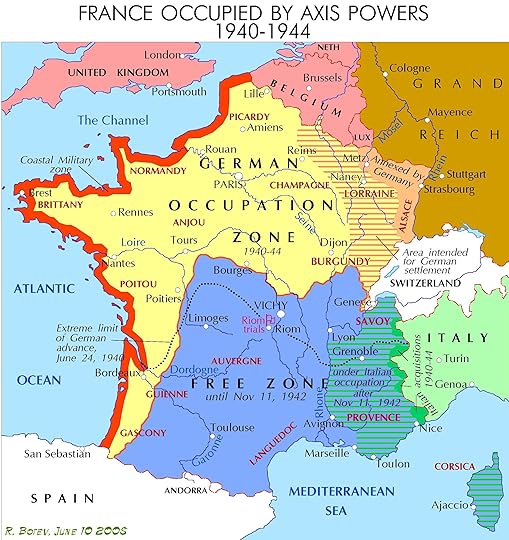

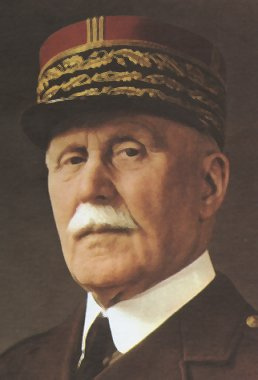
Since July 1940, upon being invaded and defeated by Nazi German forces, the autonomous French state had been split into two regions. One was occupied by German troops, and the other was unoccupied, governed by a more or less puppet regime centered in Vichy, a spa region about 200 miles southeast of Paris, and led by Gen. Philippe Petain, a World War I hero. Publicly, Petain declared that Germany and France had a common goal, "the defeat of England." Privately, the French general hoped that by playing mediator between the Axis power and his fellow countrymen, he could keep German troops out of Vichy France while surreptitiously aiding the antifascist Resistance movement.
Petain's compromises became irrelevant within two years. When Allied forces arrived in North Africa to team up with the Free French Forces to beat back the Axis occupiers, and French naval crews, emboldened by the Allied initiative, scuttled the French fleet off Toulon, in southeastern France, to keep it from being used by those same Axis powers, Hitler retaliated. In violation of the 1940 armistice agreement, German troops moved into southeastern-Vichy, France. From that point forward, Petain became virtually useless, and France merely a future gateway for the Allied counteroffensive in Western Europe, namely, D-Day.
(Source: http://www.history.com/this-day-in-hi...)
More:
http://www.time.com/time/world/articl...
http://www.bonjourlafrance.com/france...
http://www.spartacus.schoolnet.co.uk/...
http://www.bbc.co.uk/history/worldwar...
http://www.bbc.co.uk/history/historic...
http://en.wikipedia.org/wiki/Vichy_Fr...
 by Michael Curtis (no photo)
by Michael Curtis (no photo) by Robert O. Paxton (no photo)
by Robert O. Paxton (no photo) by Henry Russo (no photo)
by Henry Russo (no photo) by
by
 Colin Smith
Colin Smith by Charles Williams (no photo)
by Charles Williams (no photo) by Denis Peschanski (no photo)
by Denis Peschanski (no photo) by Barbara Will (no photo)
by Barbara Will (no photo)
 Convoy System
Convoy System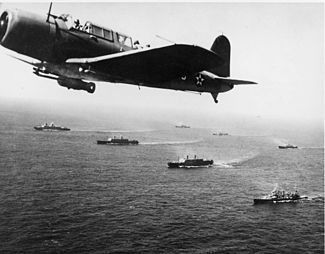
Assembling merchant vessels to sail in convoy with armed escort vessels is a standard naval defensive tactic that can limit the threat of commerce raiding surface vessels and submarines. During World War II, the Allies used the convoy system to defend large numbers of merchant ships with limited numbers of escorts. German naval leaders countered this defense with radio, marshaling multiple submarines for concentrated attacks against Allied convoys. These "group tactics" (widely known as "wolfpack") were designed to overwhelm Allied escorts, often enabling the attacking U-boats to penetrate the heart of the convoy and sink merchant ships from within.
Relying on radio communications to coordinate vessel movements from onshore headquarters, Axis and Allied naval leaders were both vulnerable to radio "signals intelligence." In coordinating their naval campaign against Allied merchant shipping, German naval leaders inadvertently provided Anglo-American intelligence trackers with a means of pinpointing Axis vessel locations, thus depriving U-boats of submarine stealth and surprise. After 1943, U.S. Navy trackers systematically used signals intelligence first to divert convoys and then to hunt down and kill the would-be Axis attackers. Without Allied convoys safely crossing the Atlantic, the decisive June 1944 "D-Day" invasion of Axis-occupied Europe might have been delayed.
(Source: http://www.marinersmuseum.org/sites/m...)
More:
http://pwencycl.kgbudge.com/C/o/Convo...
http://www.militaryhistoryonline.com/...
http://en.wikipedia.org/wiki/Anti-sub...
http://en.wikipedia.org/wiki/Convoy
http://wiki.answers.com/Q/What_was_th...
http://www.ibiblio.org/hyperwar/USN/r...
http://www.convoyweb.org.uk/index.html
http://en.wikipedia.org/wiki/List_of_...
http://jcsphotos.overblog.com/a-convo...
 by
by
 Stephen Budiansky
Stephen Budiansky by John Creighton Campbell (no photo)
by John Creighton Campbell (no photo) by
by
 Robert K. Massie
Robert K. Massie by George J. Billy (no photo)
by George J. Billy (no photo) by Vincent P. O'Hara (no photo)
by Vincent P. O'Hara (no photo) by Dorothy Pedersen (no photo)
by Dorothy Pedersen (no photo) by Michael Walling (no photo)
by Michael Walling (no photo) by Arnold Hague (no photo)
by Arnold Hague (no photo)
 Civilian Conservation Corps (CCC)
Civilian Conservation Corps (CCC)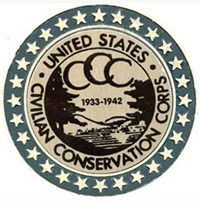
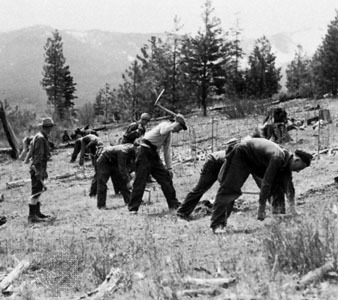

In his first 100 days in office, President Roosevelt approved several measures as part of his "New Deal," including the Emergency Conservation Work Act (ECW), better known as the Civilian Conservation Corps (CCC). With that action, he brought together the nation's young men and the land in an effort to save them both. Roosevelt proposed to recruit thousands of unemployed young men, enlist them in a peacetime army, and send them to battle the erosion and destruction of the nation's natural resources. More than any other New Deal agency, the CCC is considered to be an extension of Roosevelt's personal philosophy.
The CCC, also known as Roosevelt's Tree Army, was credited with renewing the nation's decimated forests by planting an estimated three billion trees from 1933 to 1942. This was crucial, especially in states affected by the Dust Bowl, where reforestation was necessary to break the wind, hold water in the soil, and hold the soil in place. So far reaching was the CCC's reforestation program that it was responsible for more than half the reforestation, public and private, accomplish in the nation's history.
Eligibility requirements for the CCC carried several simple stipulations. Congress required U.S. citizenship only. Other standards were set by the ECW. Sound physical fitness was mandatory because of the hard physical labor required. Men had to be unemployed, unmarried, and between the ages of 18 and 26, although the rules were eventually relaxed for war veterans. Enlistment was for a duration of six months, although many reenlisted after their alloted time was up.
Young men flocked to enroll. Many politicians believed that the CCC was largely responsible for a 55 percent reduction in crimes committed by the young men of that day. Men were paid $30 a month, with mandatory $25 allotment checks sent to families of the men, which made life a little easier for people at home.
Camps were set up in all states, as well as in Hawaii, Alaska, Puerto Rico, and the Virgin Islands. Enrollment peaked at the end of 1935, when there were 500,000 men located in 2,600 camps in operation in all states. California alone had more than 150 camps.
The program enjoyed great public support. Once the first camps were established and the CCC became better known, they became accepted and even sought after. The CCC camps stimulated regional economies and provided communities with improvements in forest activity, flood control, fire protection, and overall community safety.
In May 1933, the president authorized the enrollment of about 25,000 veterans of the Spanish American War and World War I, with no age or marital restrictions. This made it possible for more than 250,000 veterans to rebuild lives disrupted by earlier service to their country.
In June 1933, the ECW decided that men in CCC camps could be given the opportunity of vocational training and additional education. Educational programs were developed that varied considerably from camp to camp, both in efficiency and results. More than 90 percent of all enrollees participated in some facet of the educational program. Throughout the CCC, more than 40,000 illiterate men were taught to read and write.
By 1942, there was hardly a state that could not boast of permanent projects left as markers by the CCC. The CCC worked on improving millions of acres of federal and state lands, as well as parks. New roads were built, telephone lines strung, and trees planted.
Following the attack on Pearl Harbor, it became obvious that any federal project not directly related to the war effort was in jeopardy. A joint committee of Congress recommended that the CCC be abolished by July 1, 1942. Technically, however, the corps was never abolished. Congress simply refused it any additional money. Eventually, $8 million was set aside to cover all costs of liquidation, and the War Department, Labor Department, and Civil Aeronautics Administration were given first opportunity to acquire CCC properties. The War Department claimed the majority of the equipment.
The Civilian Conservation Corps was one of the most successful New Deal programs of the Great Depression. It existed for fewer than 10 years, but left a legacy of strong, handsome roads, bridges, and buildings throughout the United States. Between 1933 and 1941, more than 3,000,000 men served in the CCC.
The effects of service in the CCC were felt for years, even decades, afterwards. Following the depression, when the job market picked up, businessmen indicated a preference for hiring a man who had been in the CCC, and the reason was simple. Employers believed that anyone who had been in the CCC would know what a full day's work meant, and how to carry out orders in a disciplined way.
Today, many of the remaining physical features the CCC built have been placed on the National Register of Historic Places.
(Source: http://www.u-s-history.com/pages/h158...)
More:
http://en.wikipedia.org/wiki/Civilian...
http://www.history.com/topics/civilia...
http://www.parks.ca.gov/?page_id=24899
http://www.ccclegacy.org/
http://money.howstuffworks.com/econom...
 by Neil M. Maher (no photo)
by Neil M. Maher (no photo) by Stan Cohen (no photo)
by Stan Cohen (no photo) by Barbara W. Sommer (no photo)
by Barbara W. Sommer (no photo) by Robert Pasquill (no photo)
by Robert Pasquill (no photo) by Tara Mitchell Mielnik (no photo)
by Tara Mitchell Mielnik (no photo)
 Jane's Fighting Ships
Jane's Fighting Ships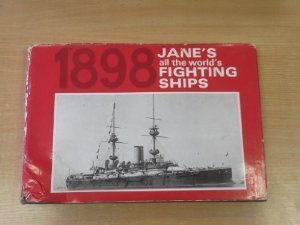
is an annual reference book of information on all the world's warships arranged by nation, including information on ship's names, dimensions, armaments, silhouettes and photographs, etc. Its annual editions cover the warships used by the different national naval and paramilitary forces, and provide data on their characteristics.
It was originally published by John F. T. Jane (usually known as "Fred T.") in 1898 as Jane's All the World's Fighting Ships.
(Source: http://en.wikipedia.org/wiki/Jane%27s...)
More:
http://www.janes.com/products/janes/d...
 & (no image) Jane's Fighting Ships, 1898: A Reprint Of The 1898 Edition Of Fighting Ships by Fred T. Jane (no photo)
& (no image) Jane's Fighting Ships, 1898: A Reprint Of The 1898 Edition Of Fighting Ships by Fred T. Jane (no photo) by Francis E. McMurtrie (no photo)
by Francis E. McMurtrie (no photo)
message 94:
by
Jerome, Assisting Moderator - Upcoming Books and Releases
(last edited Oct 06, 2014 04:33PM)
(new)
Potsdam Conference
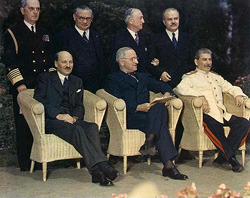
The Potsdam Conference, held near Berlin, July 17-August 2, 1945, was the last of the Big Three meetings during World War II. It was attended by Premier Joseph Stalin of the Soviet Union, the new American president, Harry S. Truman, and Prime Minister Winston Churchill of Great Britain (replaced on July 28 by his successor, Clement Attlee). On July 26, the leaders issued a declaration demanding 'unconditional surrender' from Japan, concealing the fact that they had privately agreed to let Japan retain its emperor. Otherwise, the conference centered on postwar Europe. A Council of Foreign Ministers was agreed upon, with membership from the Big Three plus China and France.
Military administration of Germany was established, with a central Allied Control Council (the requirement that all decisions be unanimous would later prove to be crippling). The leaders arrived at various agreements on the German economy, placing primary emphasis on the development of agriculture and nonmilitary industry. The institutions that had controlled the economy under the Nazis were to be decentralized, but all of Germany would be treated as a single economic unit. War criminals would be brought to trial. Stalin's request to define the Polish-German border was put off till the peace treaty, but the conference accepted his transfer of the land east of the Oder and Neisse rivers from Germany to Poland. Regarding reparations, a compromise was worked out, based on an exchange of capital equipment from the Western zone for raw materials from the East. It resolved a dispute but set the precedent of managing the German economy by zone rather than comprehensively as the Western powers had hoped.
Although postwar Europe dominated the Potsdam agenda, the war in the Pacific lurked offstage. Truman received word of the successful atomic bomb test soon after he arrived at Potsdam; he told Churchill the news but mentioned 'a new weapon' only casually to Stalin. Truman continued to solicit Stalin's assistance against Japan, but he knew that if the bomb succeeded, Russian help would not be needed. Indeed, the bomb would give the United States unprecedented power in the postwar world.
(Source: http://www.history.com/topics/potsdam...)
More:
http://avalon.law.yale.edu/20th_centu...
http://www.spartacus.schoolnet.co.uk/...
http://militaryhistory.about.com/od/m...
http://www.princeton.edu/~achaney/tmv...
http://www.shapell.org/manuscript.asp...
 by Herbert Feis (no photo)
by Herbert Feis (no photo)
 by Charles L. Mee (no photo)
by Charles L. Mee (no photo)
 by
by
 Michael Dobbs
Michael Dobbs
 by David Stafford (no photo)
by David Stafford (no photo)
 by
by
 Marc Trachtenberg
Marc Trachtenberg
 by
by
 Gar Alperovitz
Gar Alperovitz
(no image)Potsdam 1945 by Wolfgang Benz (no photo)
 by Michael Neiberg (no photo)
by Michael Neiberg (no photo)
(no image)From Potsdam to the Cold War: Big Three Diplomacy 1945 1947 by James L. Gormly (no photo)

The Potsdam Conference, held near Berlin, July 17-August 2, 1945, was the last of the Big Three meetings during World War II. It was attended by Premier Joseph Stalin of the Soviet Union, the new American president, Harry S. Truman, and Prime Minister Winston Churchill of Great Britain (replaced on July 28 by his successor, Clement Attlee). On July 26, the leaders issued a declaration demanding 'unconditional surrender' from Japan, concealing the fact that they had privately agreed to let Japan retain its emperor. Otherwise, the conference centered on postwar Europe. A Council of Foreign Ministers was agreed upon, with membership from the Big Three plus China and France.
Military administration of Germany was established, with a central Allied Control Council (the requirement that all decisions be unanimous would later prove to be crippling). The leaders arrived at various agreements on the German economy, placing primary emphasis on the development of agriculture and nonmilitary industry. The institutions that had controlled the economy under the Nazis were to be decentralized, but all of Germany would be treated as a single economic unit. War criminals would be brought to trial. Stalin's request to define the Polish-German border was put off till the peace treaty, but the conference accepted his transfer of the land east of the Oder and Neisse rivers from Germany to Poland. Regarding reparations, a compromise was worked out, based on an exchange of capital equipment from the Western zone for raw materials from the East. It resolved a dispute but set the precedent of managing the German economy by zone rather than comprehensively as the Western powers had hoped.
Although postwar Europe dominated the Potsdam agenda, the war in the Pacific lurked offstage. Truman received word of the successful atomic bomb test soon after he arrived at Potsdam; he told Churchill the news but mentioned 'a new weapon' only casually to Stalin. Truman continued to solicit Stalin's assistance against Japan, but he knew that if the bomb succeeded, Russian help would not be needed. Indeed, the bomb would give the United States unprecedented power in the postwar world.
(Source: http://www.history.com/topics/potsdam...)
More:
http://avalon.law.yale.edu/20th_centu...
http://www.spartacus.schoolnet.co.uk/...
http://militaryhistory.about.com/od/m...
http://www.princeton.edu/~achaney/tmv...
http://www.shapell.org/manuscript.asp...
 by Herbert Feis (no photo)
by Herbert Feis (no photo) by Charles L. Mee (no photo)
by Charles L. Mee (no photo) by
by
 Michael Dobbs
Michael Dobbs by David Stafford (no photo)
by David Stafford (no photo) by
by
 Marc Trachtenberg
Marc Trachtenberg by
by
 Gar Alperovitz
Gar Alperovitz(no image)Potsdam 1945 by Wolfgang Benz (no photo)
 by Michael Neiberg (no photo)
by Michael Neiberg (no photo)(no image)From Potsdam to the Cold War: Big Three Diplomacy 1945 1947 by James L. Gormly (no photo)
 James Monroe
James Monroe
James Monroe was a Delegate and a Senator from Virginia and 5th President of the United States; born in Westmoreland County, Va., April 28, 1758; pursued classical studies; attended William and Mary College, Williamsburg, Va., in 1776 and left to enter the Continental Army in the Revolutionary War; appointed a lieutenant in the Third Virginia Regiment, participated in numerous engagements, and was severely wounded in the Battle of Trenton; rose to the rank of lieutenant colonel; member, State assembly 1782; Member of the Continental Congress 1783-1786; resumed the study of law; admitted to the bar and engaged in practice in Fredericksburg, Va.; member, State assembly 1786; delegate to the State convention to consider the Federal Constitution in 1788; unsuccessful candidate for election to the First Congress; elected to the United States Senate to fill the vacancy caused by the death of William Grayson; reelected in 1791 and served from November 9, 1790, until his resignation May 27, 1794; appointed by President George Washington as Minister Plenipotentiary to France 1794-1796; Governor of Virginia 1799-1802; appointed by President Thomas Jefferson as Minister Plenipotentiary to France in 1803, and Minister Plenipotentiary to England 1803-1807, and during this period headed a diplomatic mission to Spain; returned home in 1808; member, State assembly 1810-1811; Governor of Virginia 1811; appointed Secretary of State in the Cabinet of President James Madison and served from 1811 to 1817; also served as Secretary of War 1814-1815; elected in 1816 and reelected in 1820 as President of the United States and served from March 4, 1817, to March 3, 1825; retired to his farm in Loudoun County, Va.; member and president of the Virginia constitutional convention of 1829; moved to New York City in 1831, and died there July 4, 1831; interment in Marble Cemetery on Second Street, New York City; reinterred in Hollywood Cemetery, Richmond, Va., July 4, 1858.
(Source: http://bioguide.congress.gov/scripts/...)
More:
http://www.monticello.org/site/resear...
http://millercenter.org/president/monroe
http://www.whitehouse.gov/about/presi...
http://en.wikipedia.org/wiki/James_Mo...
http://www.ashlawnhighland.org/
 by Harry Ammon (no photo)
by Harry Ammon (no photo) by
by
 Gary Hart
Gary Hart by
by
 Chris DeRose
Chris DeRose by Noble E. Cunningham Jr. (no photo)
by Noble E. Cunningham Jr. (no photo) by Harlow Giles Unger (no photo)
by Harlow Giles Unger (no photo)
 Monroe Doctrine
Monroe Doctrine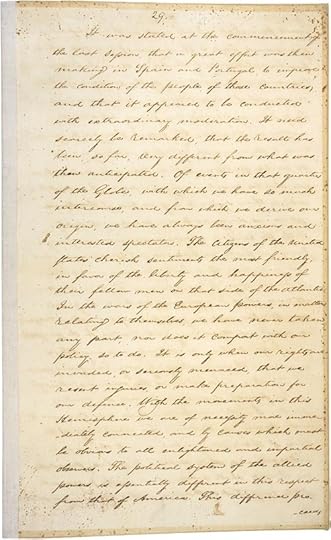
In his December 2, 1823, address to Congress, President James Monroe articulated United States' policy on the new political order developing in the rest of the Americas and the role of Europe in the Western Hemisphere.
The statement, known as the Monroe Doctrine, was little noted by the Great Powers of Europe, but eventually became a longstanding tenet of U.S. foreign policy. Monroe and his Secretary of State John Quincy Adams drew upon a foundation of American diplomatic ideals such as disentanglement from European affairs and defense of neutral rights as expressed in Washington's Farewell Address and Madison's stated rationale for waging the War of 1812. The three main concepts of the doctrine--separate spheres of influence for the Americas and Europe, non-colonization, and non-intervention--were designed to signify a clear break between the New World and the autocratic realm of Europe. Monroe's administration forewarned the imperial European powers against interfering in the affairs of the newly independent Latin American states or potential United States territories. While Americans generally objected to European colonies in the New World, they also desired to increase United States influence and trading ties throughout the region to their south. European mercantilism posed the greatest obstacle to economic expansion. In particular, Americans feared that Spain and France might reassert colonialism over the Latin American peoples who had just overthrown European rule. Signs that Russia was expanding its presence southward from Alaska toward the Oregon Territory were also disconcerting.
For their part, the British also had a strong interest in ensuring the demise of Spanish colonialism, with all the trade restrictions mercantilism imposed. Earlier in 1823 British Foreign Minister George Canning suggested to Americans that two nations issue a joint declaration to deter any other power from intervening in Central and South America. Secretary of State John Quincy Adams, however, vigorously opposed cooperation with Great Britain, contending that a statement of bilateral nature could limit United States expansion in the future. He also argued that the British were not committed to recognizing the Latin American republics and must have had imperial motivations themselves.
(Source: http://history.state.gov/milestones/1...)
More:
http://en.wikipedia.org/wiki/Monroe_D...
http://www.loc.gov/rr/program/bib/our...
http://www.ourdocuments.gov/doc.php?f...
http://www.theodoreroosevelt.org/life...
 by Jay Sexton (no photo)
by Jay Sexton (no photo) by Gaddis Smith (no photo)
by Gaddis Smith (no photo) by Edward J. Renehan Jr. (no photo)
by Edward J. Renehan Jr. (no photo) by Armin Rappaport (no photo)
by Armin Rappaport (no photo)(no image)The Monroe Doctrine: Its Modern Significance by Donald Marquand Dozer (no photo)
 Max Hastings
Max Hastings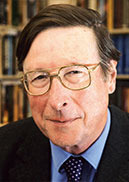
Sir Max Hastings is an author, journalist and broadcaster whose work has appeared in every British national newspaper. He now writes regularly for the Daily Mail and Financial Times, of which he is a contributing editor, and reviews books for the Sunday Times and New York Review of Books. He has published twenty-three books, among the most recent of which are All Hell Let Loose (2011); Did You Really Shoot the Television: A Family Fable (2010); Finest Years: Churchill As Warlord 1940-45 (2009); Armageddon: The Battle for Germany 1944-45 (2004) and Nemesis: The Battle For Japan 1944-45 (2007). He has also published three collections of writing about the British countryside and field sports. The son and grandson of writers, he was educated at Charterhouse (scholar) and University College, Oxford (exhibitioner), from which he dropped out to become a journalist. In 1967-68 he worked in the US after winning a World Press Institute fellowship, an experience which inspired his first book America 1968:The Fire This Time, published when he was 23.
Thereafter, he spent most of his early years as a foreign correspondent for BBC TV and the London Evening Standard, reporting eleven conflicts, notably including Vietnam and the 1982 South Atlantic war, which inspired Battle for the Falklands, the 1983 best-seller he wrote with Simon Jenkins. He was editor, then editor-in-chief, of The Daily Telegraph from 1986-1995, and of the Evening Standard 1996-2002. He has described his journalistic career in two memoirs, Going to the Wars (2000) and Editor (2002). His history of World War II All Hell Let Loose- titled Inferno in the United States- was published in 2011. His new book Catastrophe 1914 will be published in the autumn of 2013.
He has received awards both for his books and journalism. Bomber Command (1979) won the Somerset Maugham Prize. He was Journalist Of The Year and Reporter of the Year in the 1982 British Press Awards, and Editor Of The Year in 1988.
In 2008 he received the Westminster Medal of the RUSI for his lifetime contribution to Military Literature, and in 2009 the Edgar Wallace Trophy of the London Press Club.
In 2012 the Pritzker Military Library of Chicago presented him with its $100,000 Literary Award for lifetime achievement; and he again received the Duke of Westminster’s Medal for Military Literature for All Hell Let Loose.
He has presented many TV documentaries. A Fellow of the Royal Society of Literature and an Honorary Fellow of King’s College, London, he has also received honorary degrees from Leicester and Nottingham universities. He was President of the Campaign to Protect Rural England 2002-2007, and a Trustee of the National Portrait Gallery 1995-2004. He was knighted in 2002 for services to journalism. Now 66, he has two grown-up children, Charlotte who works for a London public relations company, and Harry who runs PlanSouthAmerica, a thriving travel business in Buenos Aires. Max lives with his wife Penny in West Berkshire.
(Source: http://www.maxhastings.com/about/)
More:
http://en.wikipedia.org/wiki/Max_Hast...
http://www.dailymail.co.uk/news/colum...
http://www.harpercollins.co.uk/Author...
http://ww2history.com/experts/Max_Has...
http://www.youtube.com/watch?v=cj_eA2...
http://www.youtube.com/watch?v=m_hIfU...






 by
by
 Max Hastings
Max Hastings Simon Jenkins
Simon Jenkins
Office of Strategic Services
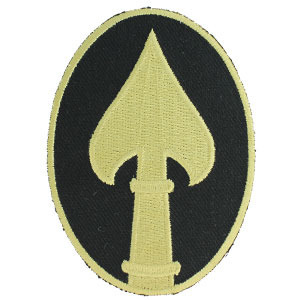
Prior to the formation of the OSS, American intelligence had been conducted on an ad-hoc basis by the various departments of the executive branch, including the State, Treasury, Navy, and War Departments. It had no overall direction, coordination, or control. The US Army and US Navy had separate code-breaking departments: Signals Intelligence Service and OP-20-G. (A previous code-breaking operation of the State Department, MI-8, run by Herbert Yardley, had been shut down in 1929 by Secretary of State Henry Stimson, deeming it an inappropriate function for the diplomatic arm, because "gentlemen don't read each other's mail".) The FBI was responsible for domestic security and anti-espionage operations.
President Franklin D. Roosevelt was concerned about American intelligence deficiencies. On the suggestion of William Stephenson, the senior British intelligence officer in the western hemisphere Roosevelt requested that William J. Donovan draft a plan for an intelligence service based on the British MI6 and Special Operations Executive. Colonel Donovan was employed to evaluate the global military position in order to offer suggestions concerning American intelligence requirements because the U.S. did not have a central intelligence agency. After submitting his work, "Memorandum of Establishment of Service of Strategic Information," Colonel Donovan was appointed as the "Co-ordinator of Information" (COI) on 11 July 1941. Thereafter the organization was developed with the assistance of the British; Donovan had responsibilities but no actual powers and the existing US agencies were sceptical if not hostile. Until some months after Pearl Harbor, the bulk of OSS intelligence came from the UK. The first OSS agents were trained by British Security Coordination (BSC) in Canada, until training stations were set up in the US with guidance from BSC instructors, who also provided information on how the SOE was arranged and managed. The British immediately made available their short-wave broadcasting capabilities to Europe, Africa and the Far East and provided equipment for agents until American production was established.
The Office of Strategic Services was established by a Presidential military order issued by President Roosevelt on June 13, 1942, to collect and analyze strategic information required by the Joint Chiefs of Staff and to conduct special operations not assigned to other agencies. During the War, the OSS supplied policy makers with facts and estimates, but the OSS never had jurisdiction over all foreign intelligence activities. The FBI was responsible for intelligence work in Latin America, and the Army and Navy guarded their areas of responsibility.
From 1943–1945, the OSS played a major role in training Nationalist troops in China and Burma, and recruited Kachin, and other indigenous irregular forces for sabotage as well as guides for Allied forces in Burma fighting the Japanese Army. Among other activities, the OSS helped arm, train and supply resistance movements, including Mao Zedong's Red Army in China and the Viet Minh in French Indochina, in areas occupied by the Axis powers during World War II. OSS officer Archimedes Patti played a central role in OSS operations in French Indochina and met frequently with Ho Chi Min in 1945.
The OSS purchased Soviet code and cipher material (or Finnish information on them) from émigré Finnish army officers in late 1944. Secretary of State Edward Stettinius, Jr., protested that this violated an agreement President Roosevelt made with the Soviet Union not to interfere with Soviet cipher traffic from the United States. General Donovan might have copied the papers before returning them the following January, but there is no record of Arlington Hall's receiving them, and CIA and NSA archives have no surviving copies. This codebook was in fact used as part of the Venona decryption effort, which helped uncover large-scale Soviet espionage in North America.
One of the greatest accomplishments of the OSS during World War II was its penetration of Nazi Germany by OSS operatives. The OSS was responsible for training German and Austrian individuals for missions inside Germany. Some of these agents included exiled communists and Socialist party members, labor activists, anti-Nazi prisoners-of-war, and German and Jewish refugees. At the height of its influence during World War II, the OSS employed almost 24,000 people.
In 1943, the Office of Strategic Services set up operations in Istanbul. Turkey, as a neutral country during the Second World War, was a place where both the Axis and Allied powers sought to set up networks of spies. The railroads connecting central Asia with Europe as well as Turkey's close proximity to the Balkan states placed it at a crossroads of intelligence gathering. The goal of the OSS Istanbul operation called Project Net-1 was to infiltrate and extenuate subversive action in the old Ottoman and Austro-Hungarian Empires.
Head of operations at OSS Istanbul was a banker from Chicago named Lanning "Packy" Macfarland who maintained the cover story as a banker for the American lend-lease program. Macfarland hired Alfred Schwarz, a Czechoslovakian engineer and businessman who came to be known as "Dogwood" and ended up establishing the notorious Dogwood information chain. Dogwood in turn hired a personal assistant named Walter Arndt and established himself as an employee of the Istanbul Western Electrik Kompani. Through Schwartz and Arndt the OSS was able to infiltrate anti-fascist groups in Austria, Hungary and Germany. Schwartz was able to convince Romanian, Bulgarian, Hungarian and Swiss diplomatic couriers to smuggle American intelligence information into these territories and establish contact with elements antagonistic to the Nazis and their collaborators. Couriers and agents memorized information and produced analytical reports; when they were not able to memorize effectively they recorded information on microfilm and hid it in their shoes or hollowed pencils. Through this process information about the Nazi regime made its way to Macfarland and the OSS in Istanbul and eventually to Washington.
While the OSS "Dogwood-chain" produced a lot of information, its reliability was increasingly questioned by British intelligence. Eventually by May 1944 through collaboration between the OSS, British intelligence, Cairo and Washington the entire "Dogwood-chain" was found to be unreliable and dangerous. Planting phony information into the OSS was intended to misdirect the resources of the Allies. Schwartz's "Dogwood – chain" which was the largest American intelligence gathering tool in occupied territory, was shortly thereafter shut down.
In 1942, a young physician named Christian J. Lambertsen invented the first device to be called SCUBA and demonstrated it to OSS – after already being rejected by the U.S. Navy – in a pool at a hotel in Washington D.C. The OSS not only bought into the concept, they hired Lambertsen to lead the program and build up the dive element of their maritime unit. His responsibilities included training and developing methods of combining self-contained diving and swimmer delivery including the Lambertsen Amphibious Respiratory Unit for the OSS "Operational Swimmer Group".
After victory in Europe in May 1945, the OSS was better able to concentrate on operations in Japan. One month after the war was won in the Pacific Theater of Operations, on September 20, 1945, President Truman signed Executive Order 9621, which came into effect as of October 1, 1945. Thus in the following days from September 20, 1945, the functions of the OSS were split between the Department of State and the Department of War. The State Department received the Research and Analysis Branch of OSS which was renamed the Interim Research and Intelligence Service or (IRIS) and headed by U.S. Army Colonel Alfred McCormack. This was later renamed the Bureau of Intelligence and Research.
The War Department took over the Secret Intelligence (SI) and Counter-Espionage (X-2) Branches, which were then housed in a new office created for just this purpose—the Strategic Services Unit (SSU). The Secretary of War appointed Brigadier General John Magruder (formerly Donovan's Deputy Director for Intelligence in OSS) as the director to oversee the liquidation of the OSS, and more importantly, the preservation of the clandestine intelligence capability of the OSS.
(Source: http://en.wikipedia.org/wiki/Office_o...)
More:
https://www.cia.gov/library/center-fo...
https://www.cia.gov/news-information/...
http://www.osssociety.org/
http://www.archives.gov/iwg/declassif...
http://www.archives.gov/research/guid...
http://www.ossog.org/
http://www.militaryhistoryonline.com/...
 by
by
 Patrick K. O'Donnell
Patrick K. O'Donnell
 by Christof Mauch (no photo)
by Christof Mauch (no photo)
 by
by
 Tom Moon
Tom Moon
 by Douglas Waller (no photo)
by Douglas Waller (no photo)
 by Elizabeth P. McIntosh (no photo)
by Elizabeth P. McIntosh (no photo)
 by Bradley F. Smith (no photo)
by Bradley F. Smith (no photo)

Prior to the formation of the OSS, American intelligence had been conducted on an ad-hoc basis by the various departments of the executive branch, including the State, Treasury, Navy, and War Departments. It had no overall direction, coordination, or control. The US Army and US Navy had separate code-breaking departments: Signals Intelligence Service and OP-20-G. (A previous code-breaking operation of the State Department, MI-8, run by Herbert Yardley, had been shut down in 1929 by Secretary of State Henry Stimson, deeming it an inappropriate function for the diplomatic arm, because "gentlemen don't read each other's mail".) The FBI was responsible for domestic security and anti-espionage operations.
President Franklin D. Roosevelt was concerned about American intelligence deficiencies. On the suggestion of William Stephenson, the senior British intelligence officer in the western hemisphere Roosevelt requested that William J. Donovan draft a plan for an intelligence service based on the British MI6 and Special Operations Executive. Colonel Donovan was employed to evaluate the global military position in order to offer suggestions concerning American intelligence requirements because the U.S. did not have a central intelligence agency. After submitting his work, "Memorandum of Establishment of Service of Strategic Information," Colonel Donovan was appointed as the "Co-ordinator of Information" (COI) on 11 July 1941. Thereafter the organization was developed with the assistance of the British; Donovan had responsibilities but no actual powers and the existing US agencies were sceptical if not hostile. Until some months after Pearl Harbor, the bulk of OSS intelligence came from the UK. The first OSS agents were trained by British Security Coordination (BSC) in Canada, until training stations were set up in the US with guidance from BSC instructors, who also provided information on how the SOE was arranged and managed. The British immediately made available their short-wave broadcasting capabilities to Europe, Africa and the Far East and provided equipment for agents until American production was established.
The Office of Strategic Services was established by a Presidential military order issued by President Roosevelt on June 13, 1942, to collect and analyze strategic information required by the Joint Chiefs of Staff and to conduct special operations not assigned to other agencies. During the War, the OSS supplied policy makers with facts and estimates, but the OSS never had jurisdiction over all foreign intelligence activities. The FBI was responsible for intelligence work in Latin America, and the Army and Navy guarded their areas of responsibility.
From 1943–1945, the OSS played a major role in training Nationalist troops in China and Burma, and recruited Kachin, and other indigenous irregular forces for sabotage as well as guides for Allied forces in Burma fighting the Japanese Army. Among other activities, the OSS helped arm, train and supply resistance movements, including Mao Zedong's Red Army in China and the Viet Minh in French Indochina, in areas occupied by the Axis powers during World War II. OSS officer Archimedes Patti played a central role in OSS operations in French Indochina and met frequently with Ho Chi Min in 1945.
The OSS purchased Soviet code and cipher material (or Finnish information on them) from émigré Finnish army officers in late 1944. Secretary of State Edward Stettinius, Jr., protested that this violated an agreement President Roosevelt made with the Soviet Union not to interfere with Soviet cipher traffic from the United States. General Donovan might have copied the papers before returning them the following January, but there is no record of Arlington Hall's receiving them, and CIA and NSA archives have no surviving copies. This codebook was in fact used as part of the Venona decryption effort, which helped uncover large-scale Soviet espionage in North America.
One of the greatest accomplishments of the OSS during World War II was its penetration of Nazi Germany by OSS operatives. The OSS was responsible for training German and Austrian individuals for missions inside Germany. Some of these agents included exiled communists and Socialist party members, labor activists, anti-Nazi prisoners-of-war, and German and Jewish refugees. At the height of its influence during World War II, the OSS employed almost 24,000 people.
In 1943, the Office of Strategic Services set up operations in Istanbul. Turkey, as a neutral country during the Second World War, was a place where both the Axis and Allied powers sought to set up networks of spies. The railroads connecting central Asia with Europe as well as Turkey's close proximity to the Balkan states placed it at a crossroads of intelligence gathering. The goal of the OSS Istanbul operation called Project Net-1 was to infiltrate and extenuate subversive action in the old Ottoman and Austro-Hungarian Empires.
Head of operations at OSS Istanbul was a banker from Chicago named Lanning "Packy" Macfarland who maintained the cover story as a banker for the American lend-lease program. Macfarland hired Alfred Schwarz, a Czechoslovakian engineer and businessman who came to be known as "Dogwood" and ended up establishing the notorious Dogwood information chain. Dogwood in turn hired a personal assistant named Walter Arndt and established himself as an employee of the Istanbul Western Electrik Kompani. Through Schwartz and Arndt the OSS was able to infiltrate anti-fascist groups in Austria, Hungary and Germany. Schwartz was able to convince Romanian, Bulgarian, Hungarian and Swiss diplomatic couriers to smuggle American intelligence information into these territories and establish contact with elements antagonistic to the Nazis and their collaborators. Couriers and agents memorized information and produced analytical reports; when they were not able to memorize effectively they recorded information on microfilm and hid it in their shoes or hollowed pencils. Through this process information about the Nazi regime made its way to Macfarland and the OSS in Istanbul and eventually to Washington.
While the OSS "Dogwood-chain" produced a lot of information, its reliability was increasingly questioned by British intelligence. Eventually by May 1944 through collaboration between the OSS, British intelligence, Cairo and Washington the entire "Dogwood-chain" was found to be unreliable and dangerous. Planting phony information into the OSS was intended to misdirect the resources of the Allies. Schwartz's "Dogwood – chain" which was the largest American intelligence gathering tool in occupied territory, was shortly thereafter shut down.
In 1942, a young physician named Christian J. Lambertsen invented the first device to be called SCUBA and demonstrated it to OSS – after already being rejected by the U.S. Navy – in a pool at a hotel in Washington D.C. The OSS not only bought into the concept, they hired Lambertsen to lead the program and build up the dive element of their maritime unit. His responsibilities included training and developing methods of combining self-contained diving and swimmer delivery including the Lambertsen Amphibious Respiratory Unit for the OSS "Operational Swimmer Group".
After victory in Europe in May 1945, the OSS was better able to concentrate on operations in Japan. One month after the war was won in the Pacific Theater of Operations, on September 20, 1945, President Truman signed Executive Order 9621, which came into effect as of October 1, 1945. Thus in the following days from September 20, 1945, the functions of the OSS were split between the Department of State and the Department of War. The State Department received the Research and Analysis Branch of OSS which was renamed the Interim Research and Intelligence Service or (IRIS) and headed by U.S. Army Colonel Alfred McCormack. This was later renamed the Bureau of Intelligence and Research.
The War Department took over the Secret Intelligence (SI) and Counter-Espionage (X-2) Branches, which were then housed in a new office created for just this purpose—the Strategic Services Unit (SSU). The Secretary of War appointed Brigadier General John Magruder (formerly Donovan's Deputy Director for Intelligence in OSS) as the director to oversee the liquidation of the OSS, and more importantly, the preservation of the clandestine intelligence capability of the OSS.
(Source: http://en.wikipedia.org/wiki/Office_o...)
More:
https://www.cia.gov/library/center-fo...
https://www.cia.gov/news-information/...
http://www.osssociety.org/
http://www.archives.gov/iwg/declassif...
http://www.archives.gov/research/guid...
http://www.ossog.org/
http://www.militaryhistoryonline.com/...
 by
by
 Patrick K. O'Donnell
Patrick K. O'Donnell by Christof Mauch (no photo)
by Christof Mauch (no photo) by
by
 Tom Moon
Tom Moon by Douglas Waller (no photo)
by Douglas Waller (no photo) by Elizabeth P. McIntosh (no photo)
by Elizabeth P. McIntosh (no photo) by Bradley F. Smith (no photo)
by Bradley F. Smith (no photo)
 Senator Claude Pepper
Senator Claude Pepper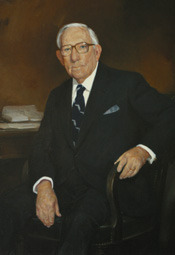
Claude Denson Pepper was born near Dudleyville, Alabama on September 8, 1900. He graduated from the University of Alabama in 1921 and from Harvard Law School in 1924. After establishing a general law practice in Perry, Florida, Pepper began his political career with his election to the Florida House of Representatives in 1929. While working in the State Capitol in 1931 he met his future wife, Mildred Webster outside the Governor's office in Tallahassee. Claude and Mildred were married on December 29, 1936 in St. Petersburg, Florida and for 43 years they were inseparable.
In 1936, Senior Florida Senator, Duncan Fletcher, died while in office and Pepper was elected to the U.S. Senate to fill the vacant seat. He quickly became a leader of the New Dealers in Congress and a friend and confidant of President Franklin Roosevelt. Against what seemed to be overwhelming opposition from conservative isolationists in 1940 and 1941, he was able to lead the fight to pass the Lend-Lease Act which allowed the U.S. to support the Allied effort in World War II. In domestic affairs, he also made a name for himself as somewhat of a "radical" by sponsoring bills for National Health Care, equal pay for equal work for women, cancer and heart disease research programs, and a minimum wage. Senator Pepper was co-author of legislation that established the National Cancer Institute, the first of many National Institutes of Health.
Following his defeat for election to a third full term in the U.S. Senate in 1950, Pepper returned to his law practice in offices in Tallahassee, Washington, and Miami. In 1963, he returned to Congress as the Representative of the newly-created 3rd Congressional District of Florida. Pepper was appointed as the Ranking Democrat on the House Select Committee on Aging when it was created in 1975 and became Chairman of that Committee in 1977. Serving as Chairman of the Committee until 1983, he became known throughout the U.S. as "Spokesman for the Elderly." In this capacity, he crusaded for an end to involuntary retirement, strengthened the Social Security system, fought age discrimination, and pushed for stronger legislation to end abuse of the elderly. He also chaired the U.S. Bipartisan Commission on Comprehensive Health Care, a body created through an amendment of his added to the 1988 Medicare Catastrophic Protection Act, and he worked tirelessly to strengthen the Medicare program.
During Claude Pepper's five decades of public service, he was a strong and effective advocate for millions of Americans in the areas of health care reform and economic security. His numerous achievements will be felt by generations to come: Americans guaranteed a decent wage, or saved from death or illness by breakthroughs in biotechnology, or protected from age discrimination in the work force or presented with a decent retirement income by the Social Security program. He left monuments such as the National Institutes of Health, a strengthened Medicare program, and a strengthened Social Security system. He achieved his goal, "to lighten the burden upon those who suffer," many times over. Senator Pepper died in Washington, D.C. on May 30, 1989.
(Source: http://claudepeppercenter.fsu.edu/con...)
More:
http://en.wikipedia.org/wiki/Claude_P...
http://bioguide.congress.gov/scripts/...
http://www.nytimes.com/learning/gener...
http://claudepeppercenter.fsu.edu/con...
http://www.britannica.com/EBchecked/t...
http://www.claudepepperfoundation.org/
http://www.nbcnews.com/video/meet-the...
http://news.google.com/newspapers?nid...
 by TRACY E. DANESE (no photo)
by TRACY E. DANESE (no photo) by Keith M. Finley (no photo)
by Keith M. Finley (no photo) by
by
 Kerwin Swint
Kerwin Swint by Brian Lewis Crispell (no photo)
by Brian Lewis Crispell (no photo) by
by
 Lynne Olson
Lynne Olson by Nancy Beck Young (no photo)
by Nancy Beck Young (no photo)
 Einstein's Letter to FDR on Atomic Bombs
Einstein's Letter to FDR on Atomic Bombs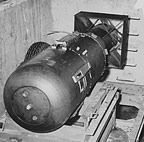

Old Grove Rd.
Nassau Point
Peconic, Long Island
August 2nd, 1939
F.D. Roosevelt
President of the United States
White House
Washington, D.C.
Sir:
Some recent work by E. Fermi and L. Szilard, which has been communicated to me in manuscript, leads me to expect that the element uranium may be turned into a new and important source of energy in the immediate future. Certain aspects of the situation which has arisen seem to call for watchfulness and, if necessary, quick action on the part of the administration. I believe therefore that it is my duty to bring to your attention the following facts and recommendations:
In the course of the last four months it has been made probable -- through the work of Joliot in France as well as Fermi and Szilard in America -- that it may become possible to set up a nuclear chain reaction in a large mass of uranium, by which vast amounts of power and large quantities of new radium like elements would be generated. Now it appears almost certain that this could be achieved in the immediate future.
This new phenomenon would also lead to the construction of bombs, and it is conceivable -- though much less certain -- that extremely powerful bombs of a new type may thus be constructed. A single bomb of this type, carried by boat and exploded in a port, might very well destroy the whole port together with some of the surrounding territory. However, such bombs might very well prove to be too heavy for transportation by air.
The United States has only very poor [illegible] of uranium in moderate quantities. There is some good ore in Canada and the former Czechoslovakia, while the most important source of Uranium is Belgian Congo.
In view of this situation you may think it desirable to have some permanent contact maintained between the Administration and the group of physicists working on chain reactions in America. One possible way of achieving this might be for you to entrust with this task a person who has your confidence and who could perhaps serve in an unofficial capacity. His task might comprise the following:
a) To approach Government Departments, keep them informed of the further development, and out forward recommendations for Government action, giving particular attention to the problem of uranium ore for the United States;
b) To speed up the experimental work, which is at present being carried on within the limits of the budgets of University laboratories, by providing funds, if such funds be required, through his contacts with private persons who are willing to make a contribution for this cause, and perhaps also by obtaining the co-operation of industrial laboratories which have the necessary equipment.
I understand that Germany has actually stopped the sale of uranium from the Czechoslovakian mines, which she has taken over. That she should have taken such early action might perhaps be understood on the ground that the son of the German Under-Secretary of State, Von Weishlicker [sic], is attached to the Kaiser Wilheim Institute in Berlin where some of the American work on uranium is now being repeated.
Yours very truly,
(Albert Einstein)
(Source: http://www.pbs.org/wgbh/americanexper...)
More:
http://en.wikipedia.org/wiki/Einstein...
http://hypertextbook.com/eworld/einst...
http://www.atomicarchive.com/Docs/Beg...
http://www.einstein-online.info/spotl...
http://discovermagazine.com/2008/mar/...
http://www.ppu.org.uk/learn/infodocs/...
 by
by
 Richard Rhodes
Richard Rhodes by Cynthia C. Kelly (no photo)
by Cynthia C. Kelly (no photo) by
by
 Kai Bird
Kai Bird by William Lanouette (no photo)
by William Lanouette (no photo) by
by
 Walter Isaacson
Walter Isaacson by Jürgen Neffe (no photo)
by Jürgen Neffe (no photo) by Silvan S. Schweber (no photo)
by Silvan S. Schweber (no photo)
Books mentioned in this topic
Eisenhower in War and Peace (other topics)Potsdam: The End of World War II and the Remaking of Europe (other topics)
An Army at Dawn: The War in North Africa, 1942-1943 (other topics)
The Guns at Last Light: The War in Western Europe, 1944-1945 (other topics)
The Day of Battle: The War in Sicily and Italy, 1943-1944 (other topics)
More...
Authors mentioned in this topic
Jean Edward Smith (other topics)Michael S. Neiberg (other topics)
Rick Atkinson (other topics)
C. Vann Woodward (other topics)
Curtis Whitfield Tong (other topics)
More...






World War I (WWI) was a global war centred in Europe that began on 28 July 1914 and lasted until 11 November 1918. It was predominantly called the World War or the Great War from its occurrence until the start of World War II in 1939, and the First World War or World War I thereafter. It involved all the world's great powers, which were assembled in two opposing alliances: the Allies (based on the Triple Entente of the United Kingdom, France and Russia) and the Central Powers (originally the Triple Alliance of Germany, Austria-Hungary and Italy; Italy did not enter into the war, as Austria–Hungary had taken the offensive against the terms of the alliance). These alliances were both reorganised and expanded as more nations entered the war: Italy, Japan and the United States joined the Allies, and the Ottoman Empire and Bulgaria the Central Powers. Ultimately, more than 70 million military personnel, including 60 million Europeans, were mobilised in one of the largest wars in history. More than 9 million combatants were killed, largely because of technological advancements that led to enormous increases in the lethality of weapons without corresponding improvements in protection or mobility, causing both sides to resort to large-scale human wave attacks, which proved extremely costly in terms of casualties. It was the fifth-deadliest conflict in world history, subsequently paving the way for various political changes, such as revolutions in many of the nations involved.
One of the long-term causes of the war was the resurgence of imperialism in the foreign policies of the great powers of Europe. More immediately, the assassination of Archduke Franz Ferdinand of Austria, the heir to the throne of Austria-Hungary, on 28 June 1914 by Yugoslav nationalist Gavrilo Princip in Sarajevo triggered a diplomatic crisis when Austria-Hungary subsequently delivered an ultimatum to the Kingdom of Serbia. Several alliances formed over the previous decades were invoked. Within weeks, the major powers were at war and, via their colonies, the conflict soon spread around the world.
On 28 July, the Austro-Hungarians fired the first shots of the war as preparation for the invasion of Serbia. While the Russians mobilised, the Germans invaded neutral Belgium and Luxembourg on the way to France, providing a casus belli for Britain's declaration of war against Germany. After the German march on Paris was brought to a halt—the so-called Miracle of the Marne—the Western Front settled into a static battle of attrition with a trench line that changed little until 1917. On the Eastern Front, the Russian army was successful against the Austro-Hungarians, but was stopped in its invasion of East Prussia by the Germans. In November the Ottoman Empire joined the war, opening up fronts in the Caucasus, Mesopotamia and the Sinai. Italy and Bulgaria went to war in 1915 and Romania in 1916. In Russia, the tsar's government collapsed in March 1917 and a subsequent revolution in November brought the Russians to terms with the Central Powers. After a 1918 German offensive along the western front, the Allies drove back the Germans in a series of successful offensives and American forces began entering the trenches. Germany, which had its own trouble with revolutionaries, agreed to an armistice on 11 November 1918. The war ended in victory for the Allies.
Events on the home fronts were as tumultuous as on the battle fronts, as the participants tried to mobilize their manpower and economic resources to fight a total war. By the end of the war, four major imperial powers—the German, Russian, Austro-Hungarian and Ottoman empires—ceased to exist. The successor states of the former two lost a great amount of territory, while the latter two were dismantled entirely. The map of central Europe was redrawn into several smaller states. The League of Nations was formed in the hope of preventing another such conflict. The European nationalism spawned by the war and the breakup of empires, the repercussions of Germany's defeat and problems with the Treaty of Versailles are agreed to be factors contributing to World War II.
In the 19th century, the major European powers had gone to great lengths to maintain a balance of power throughout Europe, resulting in the existence of a complex network of political and military alliances throughout the continent by 1900. These had started in 1815, with the Holy Alliance between Prussia, Russia, and Austria. Then, in October 1873, German Chancellor Otto von Bismarck negotiated the League of the Three Emperors (German: Dreikaiserbund) between the monarchs of Austria–Hungary, Russia and Germany. This agreement failed because Austria–Hungary and Russia could not agree over Balkan policy, leaving Germany and Austria–Hungary in an alliance formed in 1879, called the Dual Alliance. This was seen as a method of countering Russian influence in the Balkans as the Ottoman Empire continued to weaken. In 1882, this alliance was expanded to include Italy in what became the Triple Alliance.
After 1870, European conflict was averted largely through a carefully planned network of treaties between the German Empire and the remainder of Europe orchestrated by Bismarck. He especially worked to hold Russia at Germany's side to avoid a two-front war with France and Russia. When Wilhelm II ascended to the throne as German Emperor (Kaiser), Bismarck was compelled to retire and his system of alliances was gradually de-emphasised. For example, the Kaiser refused to renew the Reinsurance Treaty with Russia in 1890. Two years later, the Franco-Russian Alliance was signed to counteract the force of the Triple Alliance. In 1904, the United Kingdom signed a series of agreements with France, the Entente Cordiale, and in 1907, the United Kingdom and Russia signed the Anglo-Russian Convention. While these agreements did not formally ally the United Kingdom with France or Russia, they made British entry into any future conflict involving France or Russia probable, and the system of interlocking bilateral agreements became known as the Triple Entente.
German industrial and economic power had grown greatly after unification and the foundation of the Empire in 1871. From the mid-1890s on, the government of Wilhelm II used this base to devote significant economic resources for building up the Kaiserliche Marine (Imperial German Navy), established by Admiral Alfred von Tirpitz, in rivalry with the British Royal Navy for world naval supremacy. As a result, each nation strove to out-build the other in terms of capital ships. With the launch of HMS Dreadnought in 1906, the British Empire expanded on its significant advantage over its German rival. The arms race between Britain and Germany eventually extended to the rest of Europe, with all the major powers devoting their industrial base to producing the equipment and weapons necessary for a pan-European conflict. Between 1908 and 1913, the military spending of the European powers increased by 50 percent.
Austria-Hungary precipitated the Bosnian crisis of 1908–1909 by officially annexing the former Ottoman territory of Bosnia and Herzegovina, which it had occupied since 1878. This angered the Kingdom of Serbia and its patron, the Pan-Slavic and Orthodox Russian Empire. Russian political manoeuvring in the region destabilised peace accords, which were already fracturing in what was known as "the powder keg of Europe".
In 1912 and 1913, the First Balkan War was fought between the Balkan League and the fracturing Ottoman Empire. The resulting Treaty of London further shrank the Ottoman Empire, creating an independent Albanian State while enlarging the territorial holdings of Bulgaria, Serbia, Montenegro, and Greece. When Bulgaria attacked both Serbia and Greece on 16 June 1913, it lost most of Macedonia to Serbia and Greece and Southern Dobruja to Romania in the 33-day Second Balkan War, further destabilising the region.
(Source: http://en.wikipedia.org/wiki/World_War_I)
More:
http://www.goodreads.com/topic/group_...
http://www.history.com/topics/world-w...
http://www.bbc.co.uk/history/worldwar...
http://history1900s.about.com/od/worl...